 Recently, a flurry of bankruptcies among non-bank financial intermediaries (NBFIs) in the USA has drawn attention to the risks associated with alternative credit channels in the shadow-banking sector – lending which is not financed with deposits. There is concern that this could be the start of a wave of bankruptcies among such NBFIs, especially given concerns about a potential downswing in the economic cycle – a time when defaults are more likely.
Recently, a flurry of bankruptcies among non-bank financial intermediaries (NBFIs) in the USA has drawn attention to the risks associated with alternative credit channels in the shadow-banking sector – lending which is not financed with deposits. There is concern that this could be the start of a wave of bankruptcies among such NBFIs, especially given concerns about a potential downswing in the economic cycle – a time when defaults are more likely.
While providing alternative sources of funding, the opacity of lending in the shadow-banking sector means it is not clear what risks NBFIs face themselves and, more significantly, what risks they pose to the financial system as a whole. There is particular concern about the impact on regulated banks.
Already, JP Morgan Chase in its third quarter earnings report announced a $170m charge stemming from the bankruptcy of Tricolor, which specialised in sub-prime car financing. Mid-sized banks, Western Alliance and Zions Bancorp, have reported losses from loans to a group of distressed real estate funds. This has highlighted the interconnectedness between NBFIs and regulated banking, and the potential for problems in the shadow-banking sector to have a direct impact on mainstream banks.
In this blog, we will trace the secular trends in the financial systems of more advanced economies which have given rise to alternative credit channels and, in turn, to potential banking crises. We will explain the relationship between regulated banks and shadow banks, analysing the risks involved, the potential impact on the financial system and the policy implications.
What are the secular trends in banking?
The traditional model of commercial banking involved taking deposits and using them to finance loans to households and firms. However, cycles of banking crises, regulatory changes and financial innovation over the past 50 years produced new models.
First, banks diversified away from direct lending to providing other banking services – on-balance sheet activities, such as investing in financial securities, and off-balance sheet activities, such as acting as agents in the sale of financial securities.
Second, alternative credit channels based on financial markets have grown in significance.
 In the 1980s, international regulations around traditional banking activities – taking deposits and making loans – were being formalised by the Bank for International Settlements (BIS) under what became known as the Basel framework (see, for example, Economics section 18.2 or Economics for Business section 28.2). For the first time, this stipulated liquidity and capital requirements for international banks relating to their traditional lending activities. However, at the same time the deregulation of financial markets and financial innovation provided banks with opportunities to derive revenues from a range of other financial services.
In the 1980s, international regulations around traditional banking activities – taking deposits and making loans – were being formalised by the Bank for International Settlements (BIS) under what became known as the Basel framework (see, for example, Economics section 18.2 or Economics for Business section 28.2). For the first time, this stipulated liquidity and capital requirements for international banks relating to their traditional lending activities. However, at the same time the deregulation of financial markets and financial innovation provided banks with opportunities to derive revenues from a range of other financial services.
After the financial crisis, liquidity and capital requirements for banks were tightened further through the Basel III regulations. Commercial banks had to have even higher levels of capital as a buffer for bad debts associated with direct lending. A higher level of capital to cover potential losses increases the marginal cost of lending, since each pound of additional loan requires additional capital. This reduced the marginal return, and consequently, the incentive to lend directly.
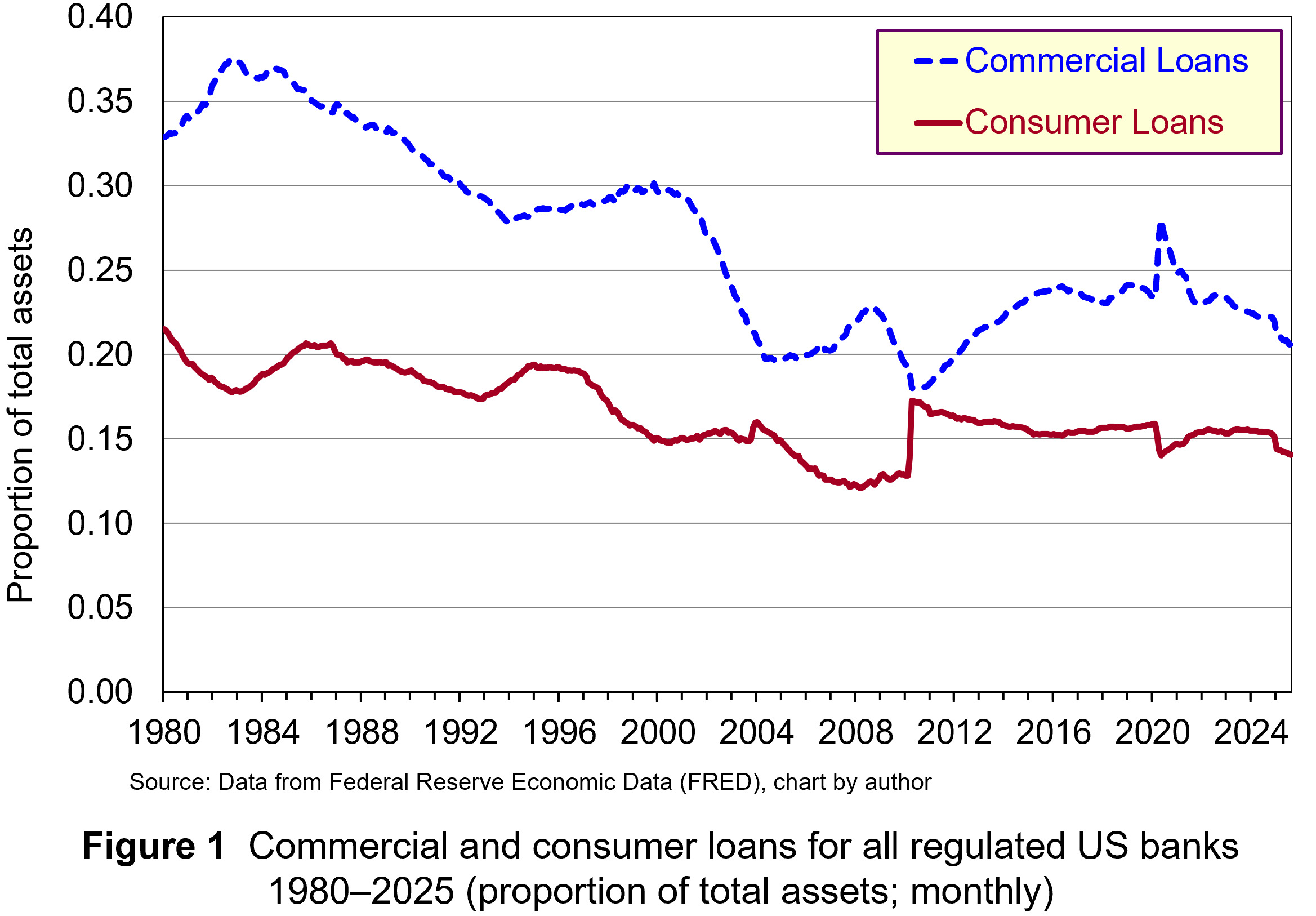 These regulatory developments created an incentive to pursue activities which do not require as much capital, since their marginal cost is lower and potential return is higher. Consequently, banks have placed less emphasis on lending and more on purchasing short-term and long-term financial securities and generating non-interest income from off-balance sheet activities. For instance, research by the Bank of England found that during the 1980s, interest income accounted for more than two-thirds of total income for large international banks. In contemporary times, non-interest income tends to be greater than interest income. Figure 1 illustrates the declining proportion of total assets represented by commercial and consumer loans for all regulated US banks. (Click here for a PowerPoint.)
These regulatory developments created an incentive to pursue activities which do not require as much capital, since their marginal cost is lower and potential return is higher. Consequently, banks have placed less emphasis on lending and more on purchasing short-term and long-term financial securities and generating non-interest income from off-balance sheet activities. For instance, research by the Bank of England found that during the 1980s, interest income accounted for more than two-thirds of total income for large international banks. In contemporary times, non-interest income tends to be greater than interest income. Figure 1 illustrates the declining proportion of total assets represented by commercial and consumer loans for all regulated US banks. (Click here for a PowerPoint.)
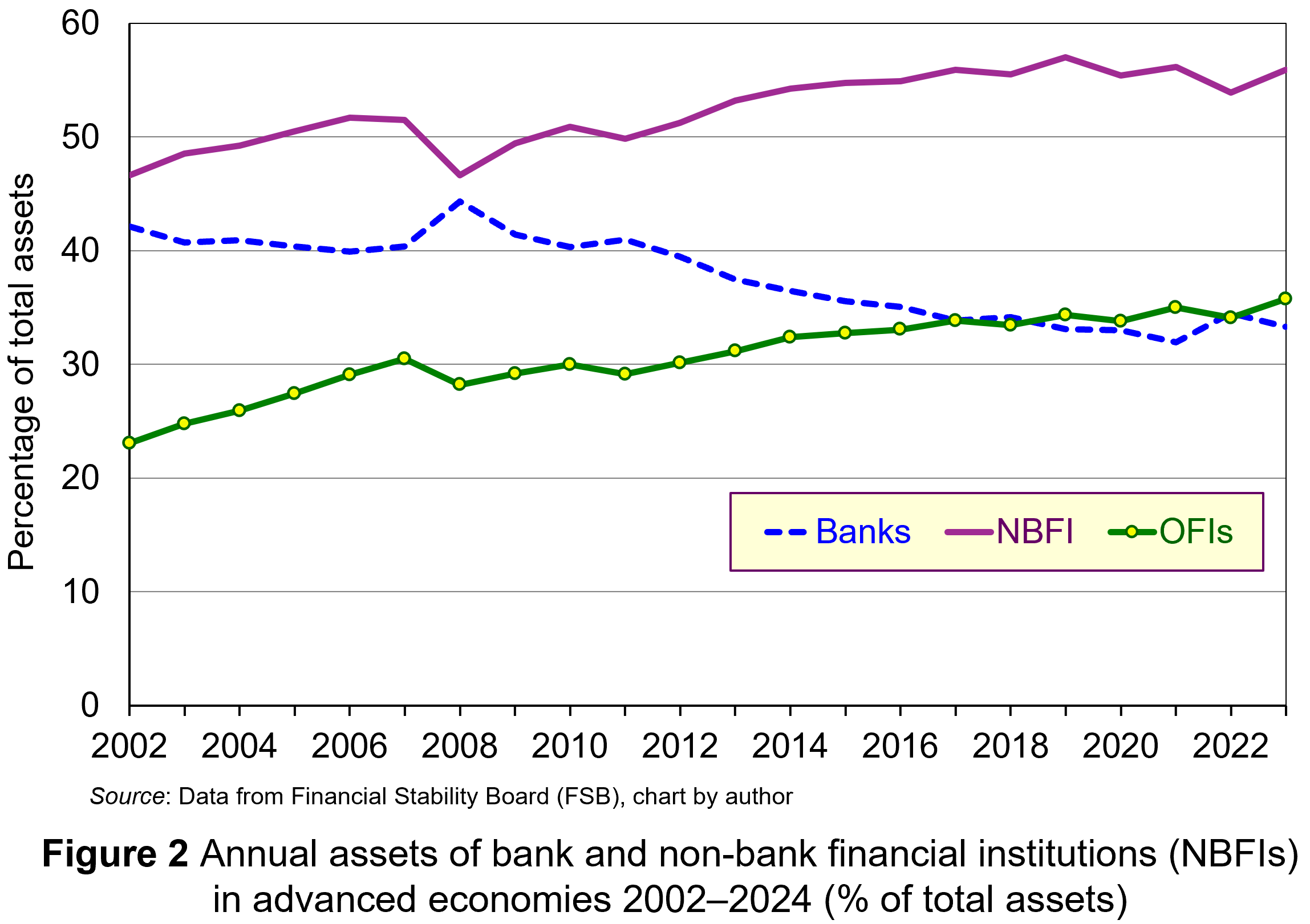 With banks originating less lending, activity has migrated to different avenues in the shadow-banking sector. This sector has always existed, but deregulation and financial innovation created opportunities for the growth of shadow banking – lending which is not financed with deposits. Traditionally, non-bank financial intermediaries (NBFIs), such as pension funds, hedge funds and insurance companies, use funds from investors to buy securities through financial markets. However, new types of NBFIs have emerged which originate loans themselves, notably private credit institutions. As Figure 2 illustrates, a lot of the expansion in the activities of NBFIs has been the due to increased lending by these institutions (defined as ‘other financial institutions (OFIs)). Note that the NBFI line includes OFIs. (Click here for a PowerPoint.)
With banks originating less lending, activity has migrated to different avenues in the shadow-banking sector. This sector has always existed, but deregulation and financial innovation created opportunities for the growth of shadow banking – lending which is not financed with deposits. Traditionally, non-bank financial intermediaries (NBFIs), such as pension funds, hedge funds and insurance companies, use funds from investors to buy securities through financial markets. However, new types of NBFIs have emerged which originate loans themselves, notably private credit institutions. As Figure 2 illustrates, a lot of the expansion in the activities of NBFIs has been the due to increased lending by these institutions (defined as ‘other financial institutions (OFIs)). Note that the NBFI line includes OFIs. (Click here for a PowerPoint.)
Since, NBFIs operate outside conventional regulatory frameworks, their credit intermediation and maturity transformation are not subject to the same capital requirements or oversight that banks are. As a result, they do not need to have the same level of capital to insulate against loan losses. Therefore, lending in the shadow-banking sector has a lower marginal cost compared to equivalent lending in the banking sector. Consequently, it generates a higher rate of return. This can explain the large growth in the assets of OFIs illustrated in Figure 2.
Risks in shadow banking
 Banking involves trade-offs and this is the case whether the activities happen in the regulated or shadow-banking sector. Increasing lending increases profitability. But as lending continues to increase, at some point the risk-return profile becomes less favourable since institutions are lending to increasingly higher-risk borrowers and for higher-risk projects.
Banking involves trade-offs and this is the case whether the activities happen in the regulated or shadow-banking sector. Increasing lending increases profitability. But as lending continues to increase, at some point the risk-return profile becomes less favourable since institutions are lending to increasingly higher-risk borrowers and for higher-risk projects.
In downturns, when rates of defaults rise, such risks become apparent. Borrowers fail and default, causing significant loan losses for lenders. With lower levels of capital, NBFIs will have a lower buffer to insulate investors from these losses, increasing the likelihood of default.
Is this a problem? Well, for a long-time regulators thought not. It was thought that failures in the shadow-banking sector would have no implications for deposit-holders in regulated banks and the payments mechanism. Unfortunately, current developments in the USA have highlighted that this is unlikely to be the case.
The connections between regulated and shadow banking
 The financial system is highly interconnected, and each successive financial crisis has shown that systemic risks lurk in obscure places. On the face of it, NBFIs appear separate from regulated banks. But banks’ new business models have not removed them from the lending channel, merely changed their role. Short-term financing used to be conducted and funded by banks. Now, it is conducted by NBFIs, but still financed by banks. Long-term loan financing is no longer on banks’ balance sheets. However, while the lending is conducted by NBFIs, it is largely funded by banks.
The financial system is highly interconnected, and each successive financial crisis has shown that systemic risks lurk in obscure places. On the face of it, NBFIs appear separate from regulated banks. But banks’ new business models have not removed them from the lending channel, merely changed their role. Short-term financing used to be conducted and funded by banks. Now, it is conducted by NBFIs, but still financed by banks. Long-term loan financing is no longer on banks’ balance sheets. However, while the lending is conducted by NBFIs, it is largely funded by banks.
NBFIs cannot be repositories of liquidity. Since they do not have deposits and are not part of the payments system, they have no access to official liquidity backstops. So, they do so indirectly by using deposit-taking banks as liquidity insurance. Banks provide this liquidity in a variety of ways:
- Investing in the securities issued by private capital funds;
- Providing bridge financing to credit managers to securitise credit card receivables;
- Providing prime broker financing to a hedge fund engaged in proprietary trading.
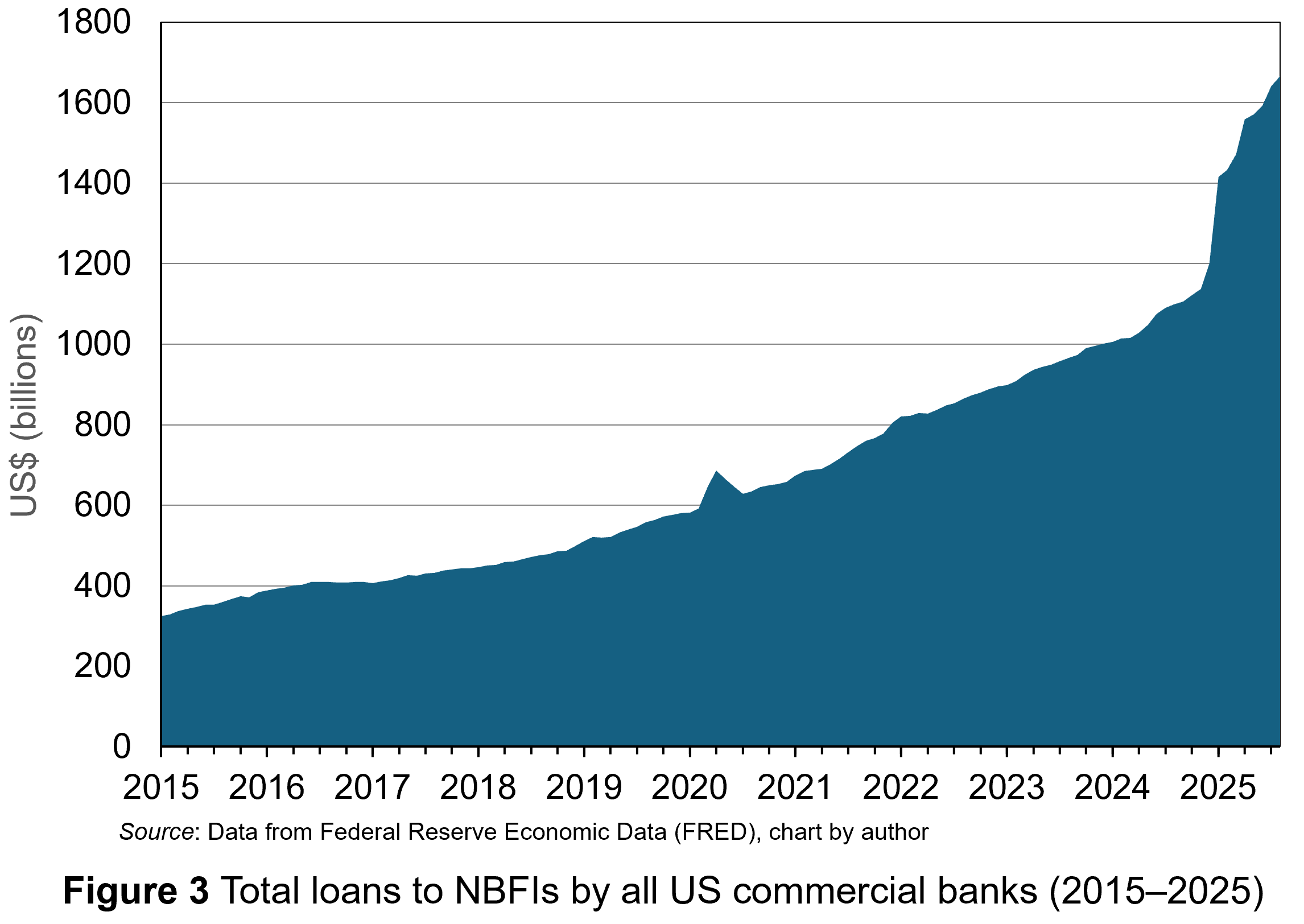 Furthermore, banks have increasingly made loans to NBFIs. Data for US commercial banks lending to the shadow-banking sector are publicly available only since 2015. But, as Figure 3 illustrates, it has seen a steady upward trend with a surge in activity in 2025. (Click here for a PowerPoint.)
Furthermore, banks have increasingly made loans to NBFIs. Data for US commercial banks lending to the shadow-banking sector are publicly available only since 2015. But, as Figure 3 illustrates, it has seen a steady upward trend with a surge in activity in 2025. (Click here for a PowerPoint.)
Banks had an incentive to diversify into these activities since they are a source of revenue requiring less regulatory capital. The model requires risk and return to follow capital out of the banking system into the shadow-banking sector. However, while risky capital and its associated expected return have moved in the shadow-banking system, not all of the liquidity and credit default risk may have done so. Ultimately, some of that risk may be borne by the deposit-holders of the banks.
This is not an issue if banks are fully aware of the risks. However, problems arise when banks do not know the full risks they are taking.
There are reasons why this may be the case. Credit markets involve significant asymmetric information between lenders and borrowers. This creates conditions for the classic problems of moral hazard and adverse selection.
Moral hazard is a hidden action problem, whereby borrowers take greater risks because they share the possible downside losses with the lender. Adverse selection is the hidden information problem, whereby lenders do not have full information about the riskiness of borrowers or their activities.
The economics of information suggests that banks exploit scale, scope and learning economies to overcome the costs associated with asymmetric information in lending. However, that applies to direct lending when banks have full information about credit default risk on their loan book. When banks finance lending indirectly through NBFIs, there is an extension of the intermediation chain, and while banks may know the NBFIs, they will have much less information about the risks associated with the lending they are ‘underwriting’. This heightens their problems of asymmetric information associated with credit default risk.
What are the risks at present?
 The level of debt in the global economy is at unprecedented levels. Data from the International Monetary Fund (IMF) show that it rose to $351 trillion dollars in 2024, approximately 235% of weighted global gross domestic product (GDP). It is in this environment that private credit channels through NBFIs have been expanding. With this, it is more likely that NBFIs’ trade-off between credit risk and return has tilted greatly in favour of the former. Some point to the recent collapse of Tricolor and First Brands – both intermediary financing companies funded by private credit – as evidence of elevated levels of risk.
The level of debt in the global economy is at unprecedented levels. Data from the International Monetary Fund (IMF) show that it rose to $351 trillion dollars in 2024, approximately 235% of weighted global gross domestic product (GDP). It is in this environment that private credit channels through NBFIs have been expanding. With this, it is more likely that NBFIs’ trade-off between credit risk and return has tilted greatly in favour of the former. Some point to the recent collapse of Tricolor and First Brands – both intermediary financing companies funded by private credit – as evidence of elevated levels of risk.
Many are pointing out that the failures observed in the USA so far have a whiff of fraud associated with them, with suggestions of multiple loans being secured against the same working capital. However, such behaviour is symptomatic of ‘late-cycle’ lending, where the incentive to squeeze more profit from lending in a more competitive environment leads to short-cuts – short-cuts that banks, at one stage removed along the intermediation chain, will have less information about.
It is in a downturn that such risks become apparent. Widening credit spreads and the reduced availability of credit causes financial stress for higher-risk borrowers. Inevitably, that higher risk will lead to higher defaults, more provision for loan losses and write-downs in the value of loan assets.
While investors in NBFIs are first in line to bear the losses, they are not the only ones exposed. At moments of stress, the credit lines that banks have provided get drawn and that increases the exposure of banks to the risks associated with NBFIs and whoever they have lent to. As NBFIs fail, the financing provided by banks will not be repaid and they will thus have to absorb losses associated with the lending of the NBFIs. So, while it appears that risk has left the banking system, it hasn’t. Ultimately, the liquidity and credit default risk of the non-bank sector is financed by bank deposits.
Furthermore, the opaqueness of the exposure of banks to risks in the shadow-banking sector may have issues for the wider financial system. In 2008, banks became wary of lending to each other during the financial crisis because they didn’t know the exposure of counterparty institutions to losses from securitised debt instruments. Now, as more and more banks reveal exposures to NBFIs, concerns about the unknown position of other banks may produce a repeat of the credit crunch which occurred then. A seizing up of credit markets will worsen any downturn. However, unlike 2008, the financial resources available to central banks and governments to deal with any consequences are severely limited.
Only time and the path of the US economy will reveal the extent of any contagion related to lending in the shadow-banking sector. However, central banks are already worried about the risks associated with the shadow-banking sector and have been taking steps to identify and ameliorate them. Events in the USA over the past few weeks may accelerate the process and bring more of that lending within the regulatory cordon.
Articles
- Bank chief says US firm collapses ring ‘alarm bells’
BBC News, Michael Sheils McNamee (21/10/25)
- BoE finds non-bank financial firms pose wider risks in crisis periods
Reuters, Lawrence White (2/12/24)
- Global Debt Remains Above 235% of World GDP
IMF Blogs, Vitor Gaspar, Carlos Eduardo Goncalves and Marcos Poplawski-Ribeiro (17/9/25)
- IMF sounds alarm about high global public debt, urges countries to build buffers
Reuters, Andrea Shalal (15/10/25)
- Major international banks performance 1980-91
Quarterly Bulletin 1992 Q3, Bank of England (1/9/92)
- Shadow Banking System: Definition, Examples, and How It Works
Investopedia, Michael Bromberg (18/10/24)
- What is private credit, and should we be worried by the collapse of US firms?
The Guardian, Kalyeena Makortoff (18/10/25)
Academic paper
Data
Questions
- Explain why the need to hold more capital raises its cost for banks.
- Why does this reduce the lending they undertake?
- What is the attraction of ‘off-balance sheet transactions’ for regulated banks?
- Analyse the asymmetric information that banks face when providing liquidity to non-bank financial institutions (NBFIs).
- Examine the dangers for the financial system associated with regulated banks’ exposure to NBFIs?
- Discuss some policy recommendations regarding bank lending to NBFIs.
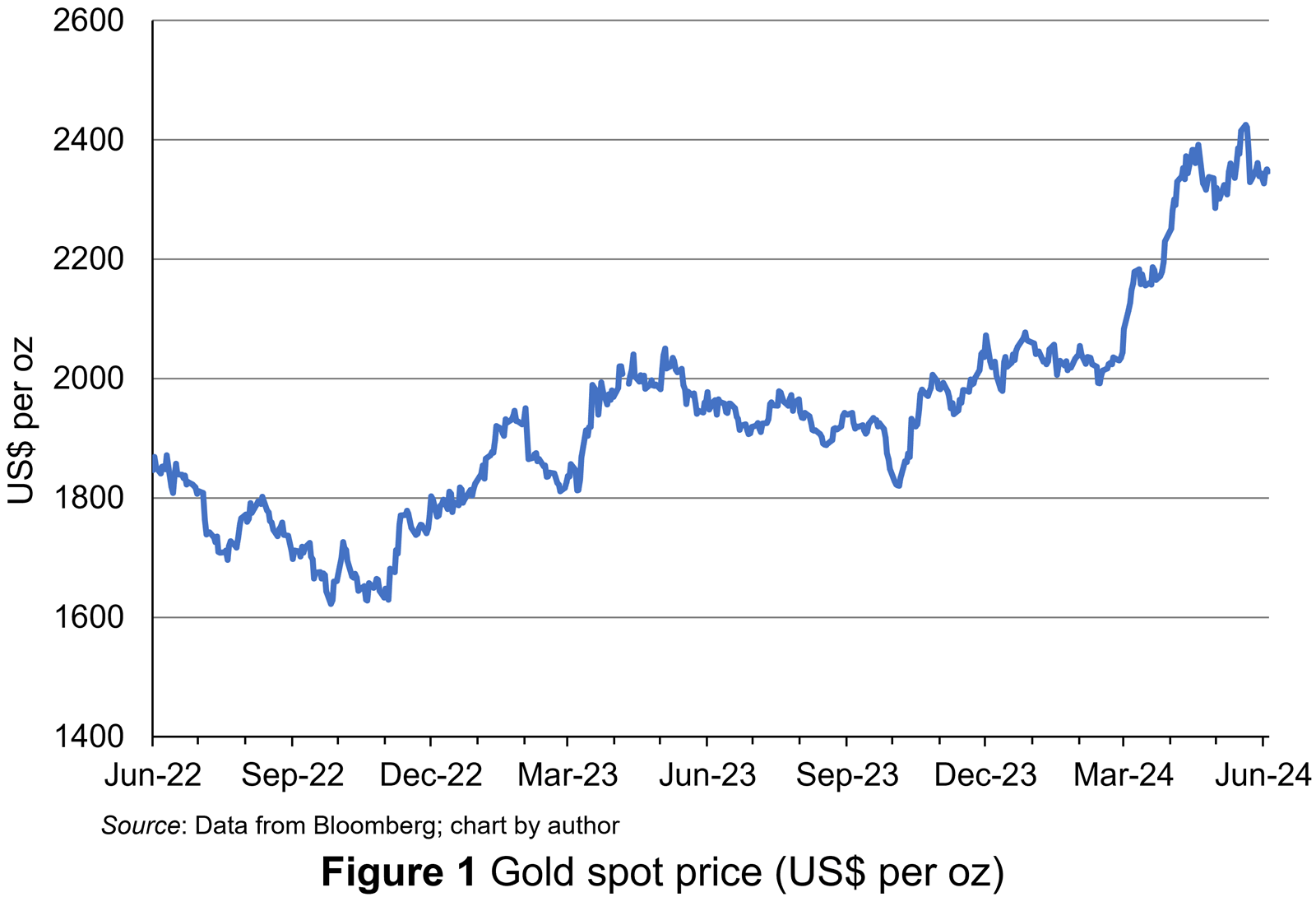 Gold has always held an allure and with the price of gold on international markets trending upwards since October 2022 (see Figure 1: click here for a PowerPoint), people seem to be attracted to it once again. The price reached successively higher peaks throughout 2023 before surging to above $2300 per oz in 2024 and peaking at $2425.31 per oz on 20 May 2024.
Gold has always held an allure and with the price of gold on international markets trending upwards since October 2022 (see Figure 1: click here for a PowerPoint), people seem to be attracted to it once again. The price reached successively higher peaks throughout 2023 before surging to above $2300 per oz in 2024 and peaking at $2425.31 per oz on 20 May 2024.
While gold tends to become attractive during wartime, economic uncertainty and bouts of inflation, all of which have characterised the last few years, the sustained price rise has perplexed market analysts and economists. The rally had been expected to peter out over the past 20 months. But, as the price of gold rose to sustained higher levels, with no significant reversals, some analysts have speculated that it is not the typical short-term factors which are driving the increased demand for and price of gold but more fundamental changes in the global economic system.
This blog will first discuss the typical short-term factors which influence gold prices before discussing the potential longer-term forces that may be at work.
Short-term factors
So, what are the typical short-term economic forces which drive the demand for gold?
The most significant are the real rates of interest on financial assets. These rates represent the opportunity cost of holding an asset such as gold which offers no income stream. When the real return from financial assets like debt and equity instruments is low, the demand for and price of gold tends to be high. In contrast, when the real return from such assets is high, the price of gold tends to be lower. An explanation for this is that real rates of return are strongly related to inflation rates and investors perceive gold as a hedge against inflation since its price is positively correlated with a general rise in prices. Higher unexpected inflation reduces the real rate of return of securities like debt and equity whose value is derived from cash flows anticipated in the future. In such circumstances, gold become an attractive alternative investment. As inflationary expectations decline, real returns from financial assets should rise, and the demand for gold should fall.
 The relationship between real returns, proxied by the yield on US 10-year TIPS (Treasury inflation-protected securities), and gold prices can be used to examine this explanation. Real returns rose steadily in the aftermath of the COVID-19 pandemic. Yet the price of gold, which rose during the early stages of the pandemic in 2020, has not fallen. Instead, it has remained at elevated levels for much of that time (see Figure 2: click here for a PowerPoint).
The relationship between real returns, proxied by the yield on US 10-year TIPS (Treasury inflation-protected securities), and gold prices can be used to examine this explanation. Real returns rose steadily in the aftermath of the COVID-19 pandemic. Yet the price of gold, which rose during the early stages of the pandemic in 2020, has not fallen. Instead, it has remained at elevated levels for much of that time (see Figure 2: click here for a PowerPoint).
There have been short periods when changes in real returns seemed to have a high correlation with changes in gold prices. In late 2022, for example, falling real rates coincided with rising gold prices. The same pattern was repeated between October and December 2023. However, when real returns rose again in the New Year of 2024, in response to stubbornly higher expected inflation and the expectation of ‘higher-for-longer’ interest rates, particularly in the USA, gold prices continued to rise. Indeed, across the 5-year period the correlation coefficient between the two series is actually positive at 0.268, showing little evidence supporting this explanation for the pattern for the gold price.
Real returns in the USA, however, may not be the correct ones to consider when seeking explanations for the pattern of gold’s price. Much of the recent demand is from China. Analysts suggest that Chinese investors are looking for a safe asset to hold as their economy stagnates and real returns from alternatives, like domestic property and equity, have decreased. Further, there are some concerns that the Chinese currency, the renminbi, may be undervalued in response to the sluggish growth. Holding gold is a good hedge against inflation (currency depreciation produces inflationary pressure). Consequently, the Chinese market may be exerting pricing power in relation to real returns in a way not seen before (see the Dempsey and Leng FT article linked below).
However, some analysts suggest that the rise in price is disproportionate to these short-term factors and point to potential long-term structural changes in the global financial order which may produce significant changes in the market for gold.
Long-term factors
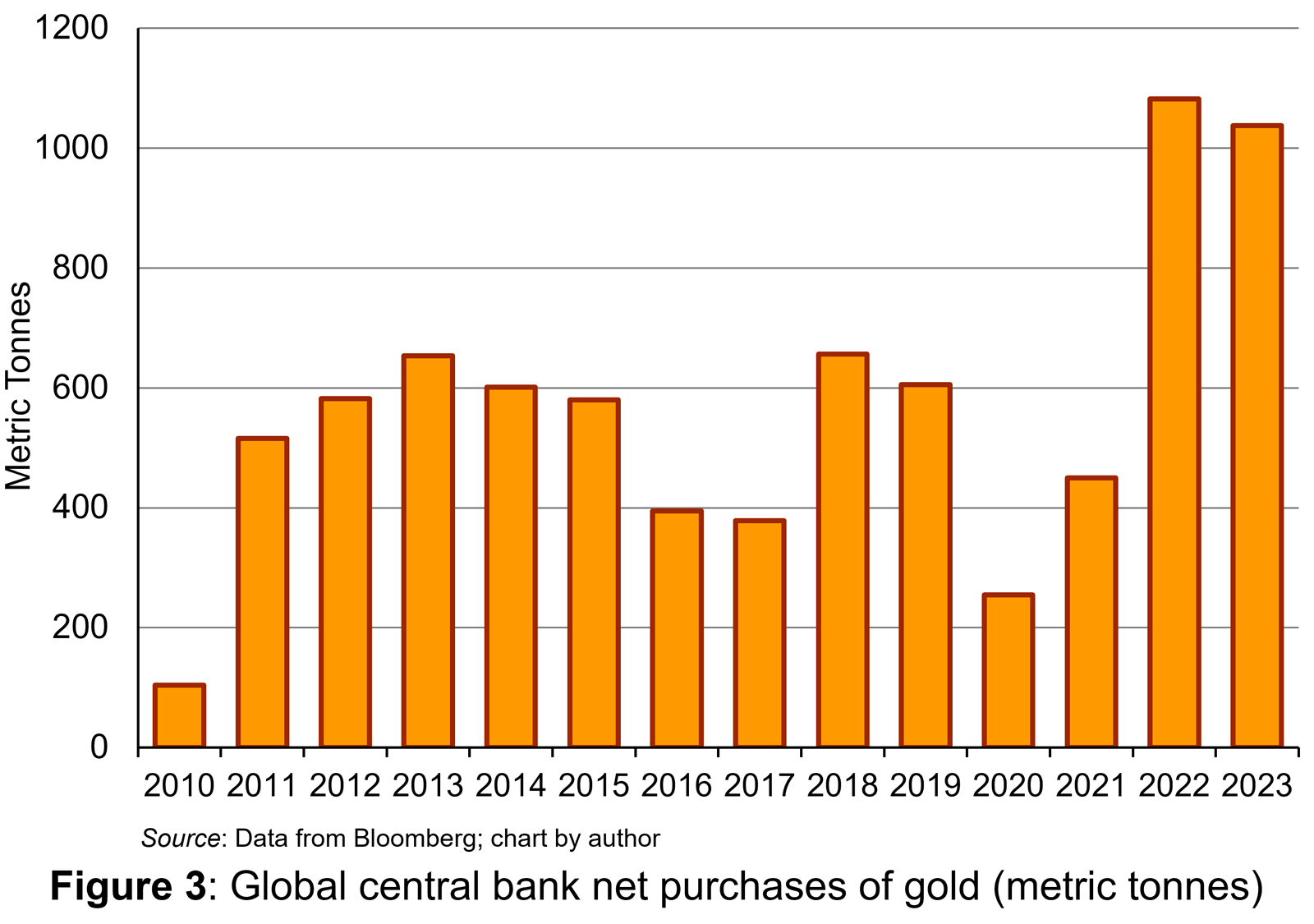 Since 2018, there have been bouts of gold purchasing by central banks around the world. In contrast to the 1990s and 2000s, central banks have been net purchasers since 2010. The purchasing fell back during the coronavirus pandemic but has surged again, with over 1000 metric tonnes purchased in both 2022 and 2023 (see Figure 3: click here for a PowerPoint).
Since 2018, there have been bouts of gold purchasing by central banks around the world. In contrast to the 1990s and 2000s, central banks have been net purchasers since 2010. The purchasing fell back during the coronavirus pandemic but has surged again, with over 1000 metric tonnes purchased in both 2022 and 2023 (see Figure 3: click here for a PowerPoint).
Analysts have pointed to similarities between the recent pattern and central bank purchases of gold during the late 1960s and early 1970s (see The Conversation article linked below). Then, central banks sought to diversify themselves from dollar-denominated assets due to concerns about higher inflation in the USA and its impact on the value of the US dollar. Under the Bretton Woods fixed exchange rate system, central banks could redeem dollars for gold from the US Federal Reserve at a fixed rate. The pressure on the USA to redeem the gold led to the collapse of the Bretton Woods fixed exchange rate system.
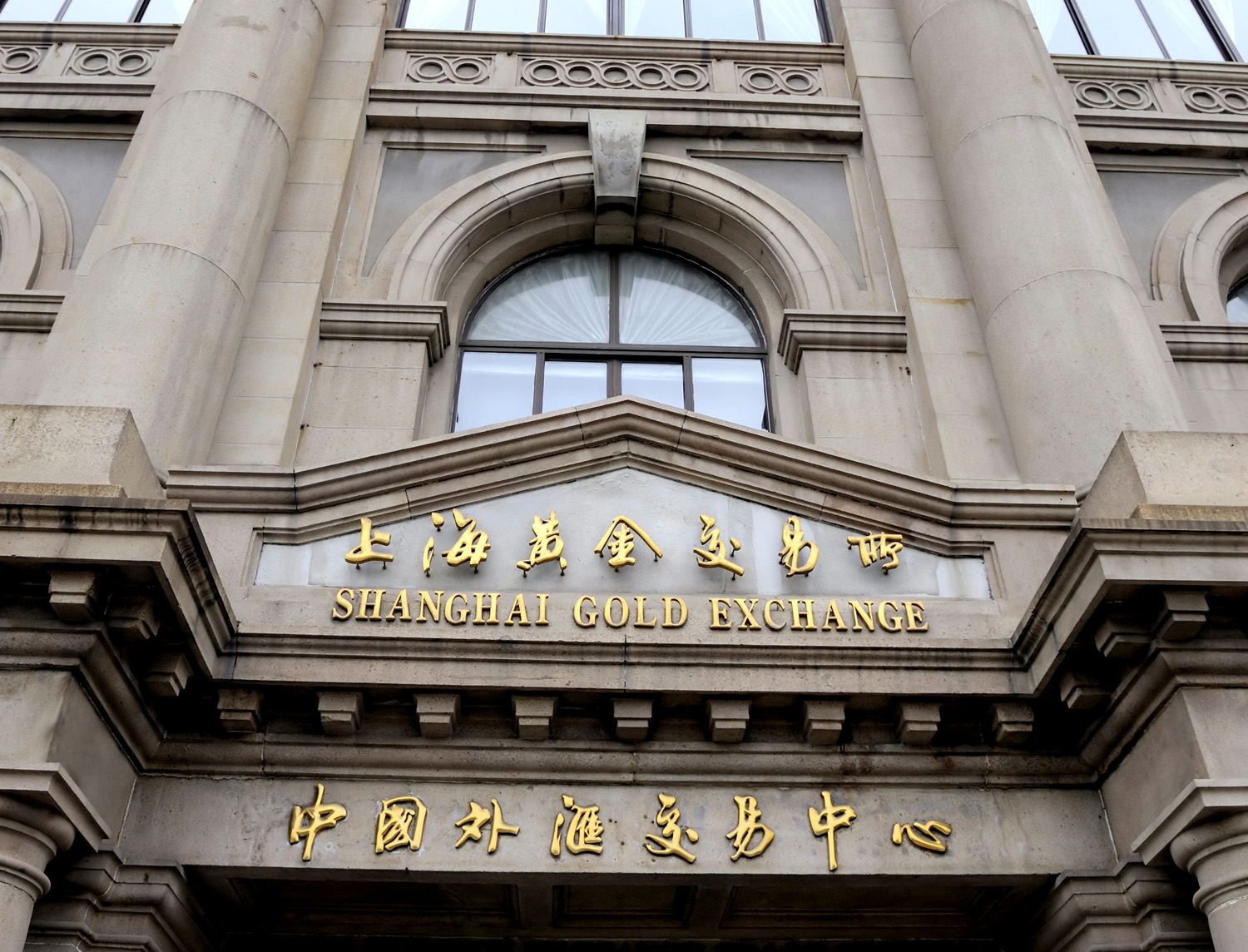 While the current period of central bank purchases does not appear to be related to expected inflation, some commentators suggest it could signal a regime change in the global financial system as significant as the collapse of Bretton Woods. The rise of Chinese political power and the resurgence of US isolationist tendencies portend an increasingly multipolar geopolitical scene. Such concerns may cause central bankers to diversify away from dollar denominated assets to avoid being caught out by geopolitical tensions. Gold may be perceived as an asset through which investors can hedge that risk better.
While the current period of central bank purchases does not appear to be related to expected inflation, some commentators suggest it could signal a regime change in the global financial system as significant as the collapse of Bretton Woods. The rise of Chinese political power and the resurgence of US isolationist tendencies portend an increasingly multipolar geopolitical scene. Such concerns may cause central bankers to diversify away from dollar denominated assets to avoid being caught out by geopolitical tensions. Gold may be perceived as an asset through which investors can hedge that risk better.
Indeed, the rise in demand among Chinese investors may indicate a reluctance to hold US assets due to their risk of seizure during heightened geopolitical tensions between China and the USA. Chinese holdings of US financial assets as a percentage of GDP are back to the level they were when the country joined the World Trade Organisation (WTO) in 2001 (see the Rana Foroohar FT article linked below). Allied to this is an increasing tendency to repatriate gold bullion from centres such as London and New York.
Added to these worries about geopolitical risk are concerns about traditional safe-haven assets – government debt securities. US government budget deficits and debt levels continue to rise. Similar patterns are observed across many developed market economies (DMEs). Analysts are concerned such debts are reaching unsustainable levels (economist.com). The view is that at some point, perhaps soon, a tipping point will be reached where investors recognise this. They will demand higher rates of return on these government debt securities, pushing yields up and prices down (bond yields and prices have a negative relationship).
In expectation of this, investors may be wary of holding such government debt securities and move to hold gold as an alternative safe-haven asset to avoid potential capital losses. However, there has been no sign of this behaviour in bond prices and yields yet.
 Finally, there are economists who argue that the increased demand for gold is caused by a different regime-change in the global economy. This is not one driven by geopolitics, but by changing inflationary expectations – from a low-inflation, low-interest-rate environment to a higher-inflation, higher-interest-rate environment.
Finally, there are economists who argue that the increased demand for gold is caused by a different regime-change in the global economy. This is not one driven by geopolitics, but by changing inflationary expectations – from a low-inflation, low-interest-rate environment to a higher-inflation, higher-interest-rate environment.
Some of the anticipation relating to inflation is derived from the persistent fiscal stimulus, evidenced by the higher government debt levels described above, coupled with the long period of monetary stimulus (quantitative easing) in developed market economies during the 2010s.
Further, some economists highlight the substantial capital investment needed for the green transition and reindustrialisation. While the financing for this capital investment may absorb some of the excess money flowing around financial markets, the scale involved will create a great demand for resources, fuelling inflation and raising the cost of capital as borrowers compete for resources.
Finally, the demographic forces from an aging population will also cause inflationary pressures. Rising dependency ratios across many developed market economics will create shortages, particularly of labour. This persistent scarcity of labour will continually drive up wages and prices, fuelling inflation and the demand for gold.
Conclusion
The recent surge in the price of gold has led to great interest by investors, financial market analysts and economists. At first, there was a perception that the price increase was similar to recent history and driven by short-term decreases in the real rate of return from financial assets, which reduced the opportunity cost of holding gold.
However, as the upward trend in the price of gold has persisted and does not seem to be explained by changes in real interest rates, economists have considered other reasons that might signal longer-term significant changes in the global financial system. These relate to changing geopolitical risk derived from an increasingly multipolar environment, concerns about the sustainability of government debt levels and expectations of persistently higher inflation in the world economy.
Only time will tell whether these explanations prove correct. If inflationary pressures subside, particularly in the USA, and if real returns from financial assets rebound, a decrease in the demand for and price of gold will suggest that the previous rise was driven by short-term forces.
If prices don’t fall back, it will only fuel the debate that it is a sign of significant changes in the global financial order.
Articles
- Gold’s weird rally
Financial Times, Robert Armstrong & Ethan Wu (11/12/23)
- A debt crisis at the economy’s edge
Financial Times, Robert Armstrong (15/5/24)
- Good, not great, news on inflation
Financial Times, Robert Armstrong (16/5/24)
- Gold prices are ‘dramatically outperforming’: Macquarie
Investing.com, Senad Karaahmetovic (30/5/24)
- Gold is back — and it has a message for us
Financial Times, Rana Foroohar (15/4/24)
- Countries went on a gold-buying spree before coronavirus took hold – here’s why
The Conversation, Drew Woodhouse (21/5/20)
- Why Gold Keeps Hitting Record Highs
Investopedia, Colin Laidley (9/4/24)
- Why Is the Price of Gold Rising?
Forbes, Wayne Duggan (23/4/24)
- Why gold prices are hitting record highs
TRT World, Kazim Alam (3/4/24)
- Chinese speculators super-charge gold rally
Financial Times, Harry Dempsey and Cheng Leng (23/4/24)
- This gold rally is made in China
Financial Times, Opinion Lex (21/5/24)
Speech
Data
Questions
- Explain the relationship between real returns and inflation for financial securities like debt and equity.
- Why is gold perceived to be an effective hedge against inflation?
- Contrast the factors which influenced the demand for gold in the period which preceded the end of Bretton Woods with those influencing demand now?
- What has happened to the price of gold since this blog was published? Is there any evidence for the profound changes in the global economic order suggested or was it the short-term forces driving demand after all?
 To finance budget deficits, governments have to borrow. They can borrow short-term by issuing Treasury bills, typically for 1, 3 or 6 months. These do not earn interest and hence are sold at a discount below the face value. The rate of discount depends on supply and demand and will reflect short-term market rates of interest. Alternatively, governments can borrow long-term by issuing bonds. In the UK, these government securities are known as ‘gilts’ or ‘gilt-edged securities’. In the USA they are known as ‘treasury bonds’, ‘T-bonds’ or simply ‘treasuries’. In the EU, countries separately issue bonds but the European Commission also issues bonds.
To finance budget deficits, governments have to borrow. They can borrow short-term by issuing Treasury bills, typically for 1, 3 or 6 months. These do not earn interest and hence are sold at a discount below the face value. The rate of discount depends on supply and demand and will reflect short-term market rates of interest. Alternatively, governments can borrow long-term by issuing bonds. In the UK, these government securities are known as ‘gilts’ or ‘gilt-edged securities’. In the USA they are known as ‘treasury bonds’, ‘T-bonds’ or simply ‘treasuries’. In the EU, countries separately issue bonds but the European Commission also issues bonds.
In the UK, gilts are issued by the Debt Management Office on behalf of the Treasury. Although there are index-linked gilts, the largest proportion of gilts are conventional gilts. These pay a fixed sum of money per annum per £100 of face value. This is known as the ‘coupon payment’ and the rate is set at the time of issue. The ‘coupon rate’ is the payment per annum as a percentage of the bond’s face value:

Payments are made six-monthly. Each issue also has a maturity date, at which point the bonds will be redeemed at face value. For example, a 4½% Treasury Gilt 2028 bond has a coupon rate of 4½% and thus pays £4.50 per annum (£2.25 every six months) for each £100 of face value. The issue will be redeemed in June 2028 at face value. The issue was made in June 2023 and thus represented a 5-year bond. Gilts are issued for varying lengths of time from 2 to 55 years. At present, there are 61 different conventional issues of bonds, with maturity dates varying from January 2024 to October 2073.
Bond prices
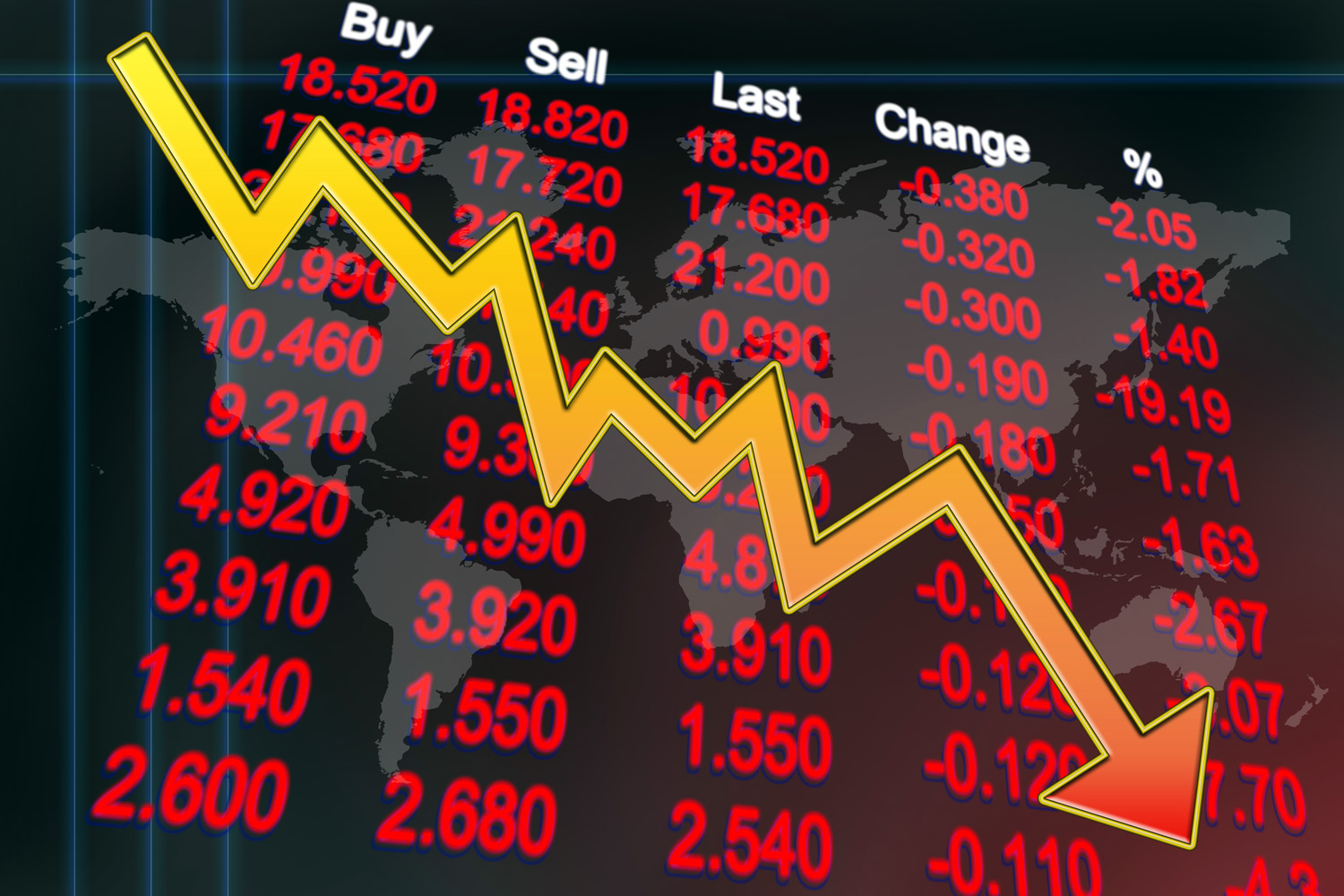 Bonds can be sold on the secondary market (i.e. the stock market) before maturity. The market price, however, is unlikely to be the coupon price (i.e. the face value). The lower the coupon rate relative to current interest rates, the less valuable the bond will be. For example, if interest rates rise, and hence new bonds pay a higher coupon rate, the market price of existing bonds paying a lower coupon rate must fall. Thus bond prices vary inversely with interest rates.
Bonds can be sold on the secondary market (i.e. the stock market) before maturity. The market price, however, is unlikely to be the coupon price (i.e. the face value). The lower the coupon rate relative to current interest rates, the less valuable the bond will be. For example, if interest rates rise, and hence new bonds pay a higher coupon rate, the market price of existing bonds paying a lower coupon rate must fall. Thus bond prices vary inversely with interest rates.
The market price also depends on how close the bonds are to maturity. The closer the maturity date, the closer the market price of the bond will be to the face value.
Bond yields: current yield
A bond’s yield is the percentage return that a person buying the bond receives. If a newly issued bond is bought at the coupon price, its yield is the coupon rate.
However, if an existing bond is bought on the secondary market (the stock market), the yield must reflect the coupon payments relative to the purchase price, not the coupon price. We can distinguish between the ‘current yield’ and the ‘yield to maturity’.
The current yield is the coupon payment as a percentage of the current market price of the bond:

Assume a bond were originally issued at 2% (its coupon rate) and thus pays £2 per annum. In the meantime, however, assume that interest rates have risen and new bonds now have a coupon rate of 4%, paying £4 per annum for each £100 invested. To persuade people to buy old bonds with a coupon rate of 2%, their market prices must fall below their face value (their coupon price). If their price halved, then they would pay £2 for every £50 of their market price and hence their current yield would be 4% (£2/£50 × 100).
Bond yields: yield to maturity (YTM)
But the current yield does not give the true yield – it is only an approximation. The true yield must take into account not just the market price but also the maturity value and the length of time to maturity (and the frequency of payments too, which we will ignore here). The closer a bond is to its maturity date, the higher/lower will be the true yield if the price is below/above the coupon price: in other words, the closer will the market price be to the coupon price for any given market rate of interest.
A more accurate measure of a bond’s yield is thus the ‘yield to maturity’ (YTM). This is the interest rate which makes the present value of all a bond’s future cash flows equal to its current price. These cash flows include all coupon payments and the payment of the face value on maturity. But future cash flows must be discounted to take into account the fact that money received in the future is worth less than money received now, since money received now could then earn interest.
The yield to maturity is the internal rate of return (IRR) of the bond. This is the discount rate which makes the present value (PV) of all the bond’s future cash flows (including the maturity payment of the coupon price) equal to its current market price. For simplicity, we assume that coupon payments are made annually. The formula is the one where the bond’s current market price is given by:

Where: t is the year; n is the number of years to maturity; YTM is the yield to maturity.
Thus if a bond paid £5 each year and had a maturity value of £100 and if current interest rates were higher than 5%, giving a yield to maturity of 8%, then the bond price would be:

In other words, with a coupon rate of 5% and a higher YTM of 8%, the bond with a face value of £100 and five years to maturity would be worth only £88.02 today.
If you know the market price of a given bond, you can work out its YTM by substituting in the above formula. The following table gives examples.
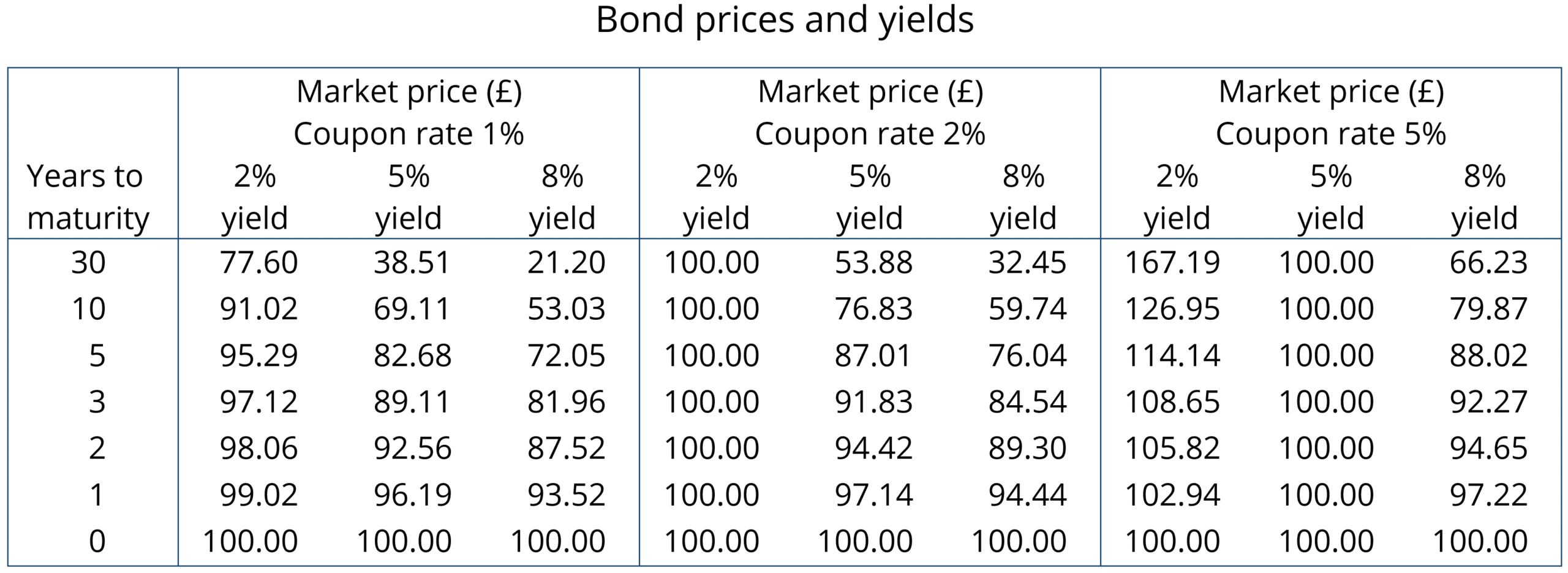
The higher the YTM, the lower the market price of a bond. Since the YTM reflects in part current rates of interest, so the higher the rate of interest, the lower the market price of any given bond. Thus bond yields vary directly with interest rates and bond prices vary inversely. You can see this clearly from the table. You can also see that market bond prices converge on the face value as the maturity date approaches.
Recent activity in bond markets
Investing in government bonds is regarded as very safe. Coupon payments are guaranteed, as is repayment of the face value on the maturity date. For this reason, many pension funds hold a lot of government bonds issued by financially trustworthy governments. But in recent months, bond prices in the secondary market have fallen substantially as interest rates have risen. For those holding existing bonds, this means that their value has fallen. For governments wishing to borrow by issuing new bonds, the cost has risen as they have to offer a higher coupon rate to attract buyers. This make it more expensive to finance government debt.
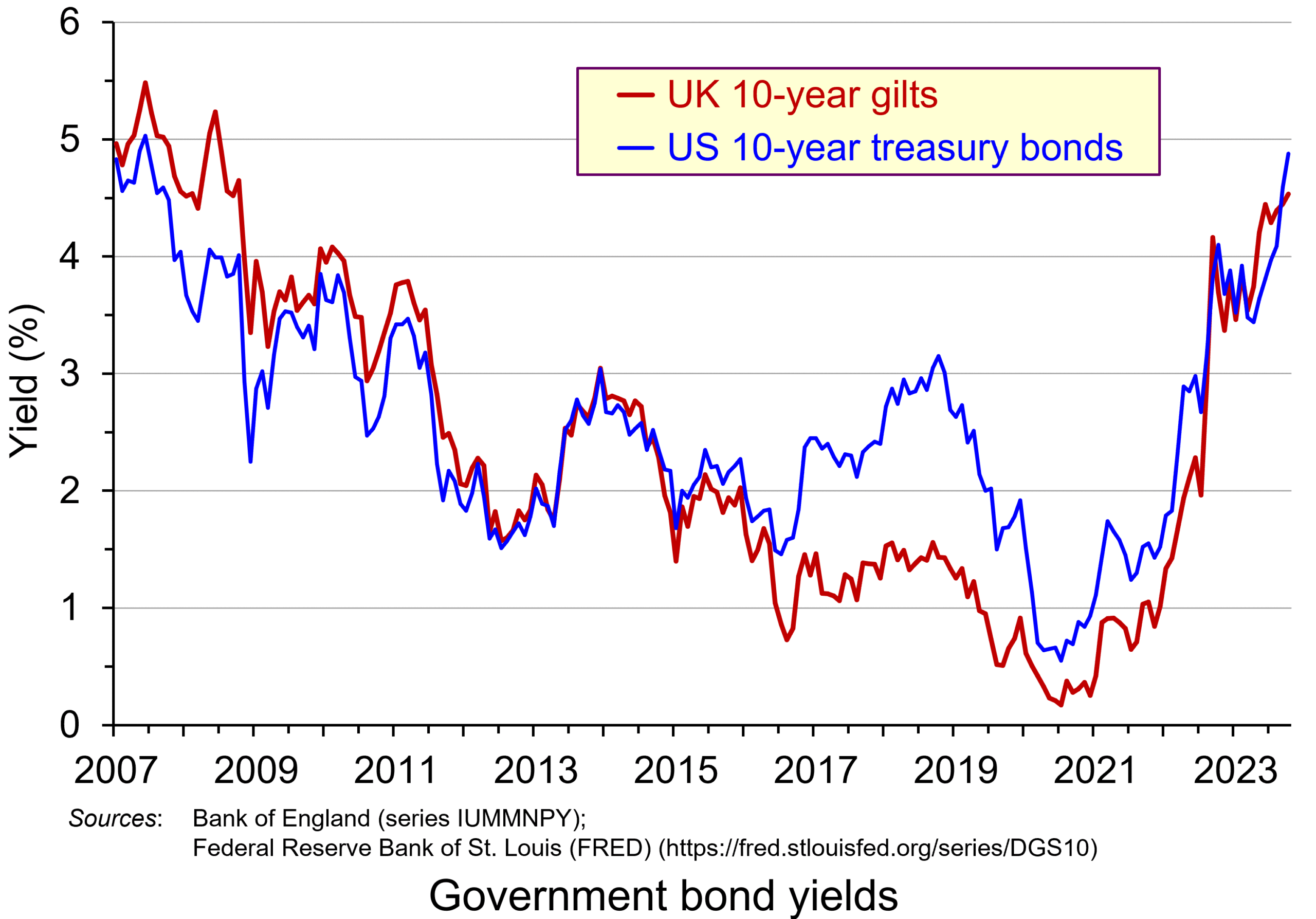 The chart shows the yield on 10-year government bonds. It is calculated using the ‘par value’ approach. This gives the coupon rate that would have to be paid for the market price of a bond to equal its face value. Clearly, as interest rates rise, a bond would have to pay a higher coupon rate for this to happen. (This, of course, is only hypothetical to give an estimate of market rates, as coupon rates are fixed at the time of a bond’s issue.)
The chart shows the yield on 10-year government bonds. It is calculated using the ‘par value’ approach. This gives the coupon rate that would have to be paid for the market price of a bond to equal its face value. Clearly, as interest rates rise, a bond would have to pay a higher coupon rate for this to happen. (This, of course, is only hypothetical to give an estimate of market rates, as coupon rates are fixed at the time of a bond’s issue.)
Par values reflect both yield to maturity and also expectations of future interest rates. The higher people expect future interest rates to be, the higher must par values be to reflect this.
 In the years following the financial crisis of 2007–8 and the subsequent recession, and again during the COVID pandemic, central banks cut interest rates and supported this by quantitative easing. This involved central banks buying existing bonds on the secondary market and paying for them with newly created (electronic) money. This drove up bond prices and drove down yields (as the chart shows). This helped support the policy of low interest rates. This was a boon to governments, which were able to borrow cheaply.
In the years following the financial crisis of 2007–8 and the subsequent recession, and again during the COVID pandemic, central banks cut interest rates and supported this by quantitative easing. This involved central banks buying existing bonds on the secondary market and paying for them with newly created (electronic) money. This drove up bond prices and drove down yields (as the chart shows). This helped support the policy of low interest rates. This was a boon to governments, which were able to borrow cheaply.
This has all changed. With quantitative tightening replacing quantitative easing, central banks have been engaging in asset sales, thereby driving down bond prices and driving up yields. Again, this can be seen in the chart. This has helped to support a policy of higher interest rates.
Problems of higher bond yields/lower bond prices
Although lower bond prices and higher yields have supported a tighter monetary policy, which has been used to fight inflation, this has created problems.
First, it has increased the cost of financing government debt. In 2007/8, UK public-sector net debt was £567bn (35.6% of GDP). The Office for Budget Responsibility forecasts that it will be £2702bn (103.1% of GDP in the current financial year – 2023/24). Not only, therefore, are coupon rates higher for new government borrowing, but the level of borrowing is now a much higher proportion of GDP. In 2020/21, central government debt interest payments were 1.2% of GDP; by 2022/23, they were 4.4% (excluding interest on gilts held in the Bank of England, under the Asset Purchase Facility (quantitative easing)).
 In the USA, there have been similar increases in government debt and debt interest payments. Debt has increased from $9tn in 2007 to $33.6tn today. Again, with higher interest rates, debt interest as a percentage of GDP has risen: from 1.5% of GDP in 2021 to a forecast 2.5% in 2023 and 3% in 2024. What is more, 31 per cent of US government bonds will mature next year and will need refinancing – at higher coupon rates.
In the USA, there have been similar increases in government debt and debt interest payments. Debt has increased from $9tn in 2007 to $33.6tn today. Again, with higher interest rates, debt interest as a percentage of GDP has risen: from 1.5% of GDP in 2021 to a forecast 2.5% in 2023 and 3% in 2024. What is more, 31 per cent of US government bonds will mature next year and will need refinancing – at higher coupon rates.
There is a similar picture in other developed countries. Clearly, higher interest payments leave less government revenue for other purposes, such as health and education.
Second, many pension funds, banks and other investment companies hold large quantities of bonds. As their price falls, so this reduces the value of these companies’ assets and makes it harder to finance new purchases, or payments or loans to customers. However, the fact that new bonds pay higher interest rates means that when existing bond holdings mature, the money can be reinvested at higher rates.
Third, bonds are often used by companies as collateral against which to borrow and invest in new capital. As bond prices fall, this can hamper companies’ ability to invest, which will lead to lower economic growth.
Fourth, higher bond yields divert demand away from equities (shares). With equity markets falling back or at best ceasing to rise, this erodes the value of savings in equities and may make it harder for firms to finance investment through new issues.
At the core of all these problems is inflation and budget deficits. Central banks have responded by raising interest rates. This drives up bond yields and drives down bond prices. But bond prices and yields depend not just on current interest rates, but also on expectations about future interest rates. Expectations currently are that budget deficits will be slow to fall as governments seek to support their economies post-COVID. Also expectations are that inflation, even though it is falling, is not falling as fast as originally expected – a problem that could be exacerbated if global tensions increase as a result of the ongoing war in Ukraine, the Israel/Gaza war and possible increased tensions with China concerning disputes in the China Sea and over Taiwan. Greater risks drive up bond yields as investors demand a higher interest premium.
Articles
Information and data
Questions
- Why do bond prices and bond yields vary inversely?
- How are bond yields and prices affected by expectations?
- Why are ‘current yield’ and ‘yield to maturity’ different?
- What is likely to happen to bond prices and yields in the coming months? Explain your reasoning.
- What constraints do bond markets place on fiscal policy?
- Would it be desirable for central banks to pause their policy of quantitative tightening?
 We have examined inflation in several blogs in recent months. With inflation at levels not seen for 40 years, this is hardly surprising. One question we’ve examined is whether the policy response has been correct. For example, in July, we asked whether the Bank of England had raised interest rates too much, too late. In judging policy, one useful distinction is between demand-pull inflation and cost-push inflation. Do they require the same policy response? Is raising interest rates to get inflation down to the target rate equally applicable to inflation caused by excessive demand and inflation caused by rising costs, where those rising costs are not caused by rising demand?
We have examined inflation in several blogs in recent months. With inflation at levels not seen for 40 years, this is hardly surprising. One question we’ve examined is whether the policy response has been correct. For example, in July, we asked whether the Bank of England had raised interest rates too much, too late. In judging policy, one useful distinction is between demand-pull inflation and cost-push inflation. Do they require the same policy response? Is raising interest rates to get inflation down to the target rate equally applicable to inflation caused by excessive demand and inflation caused by rising costs, where those rising costs are not caused by rising demand?
In terms of aggregate demand and supply, demand-pull inflation is shown by continuing rightward shifts in aggregate demand (AD); cost-push inflation is shown by continuing leftward/upward shifts in short-run aggregate supply (SRAS). This is illustrated in the following diagram, which shows a single shift in aggregate demand or short-run aggregate supply. For inflation to continue, rather than being a single rise in prices, the curves must continue to shift.
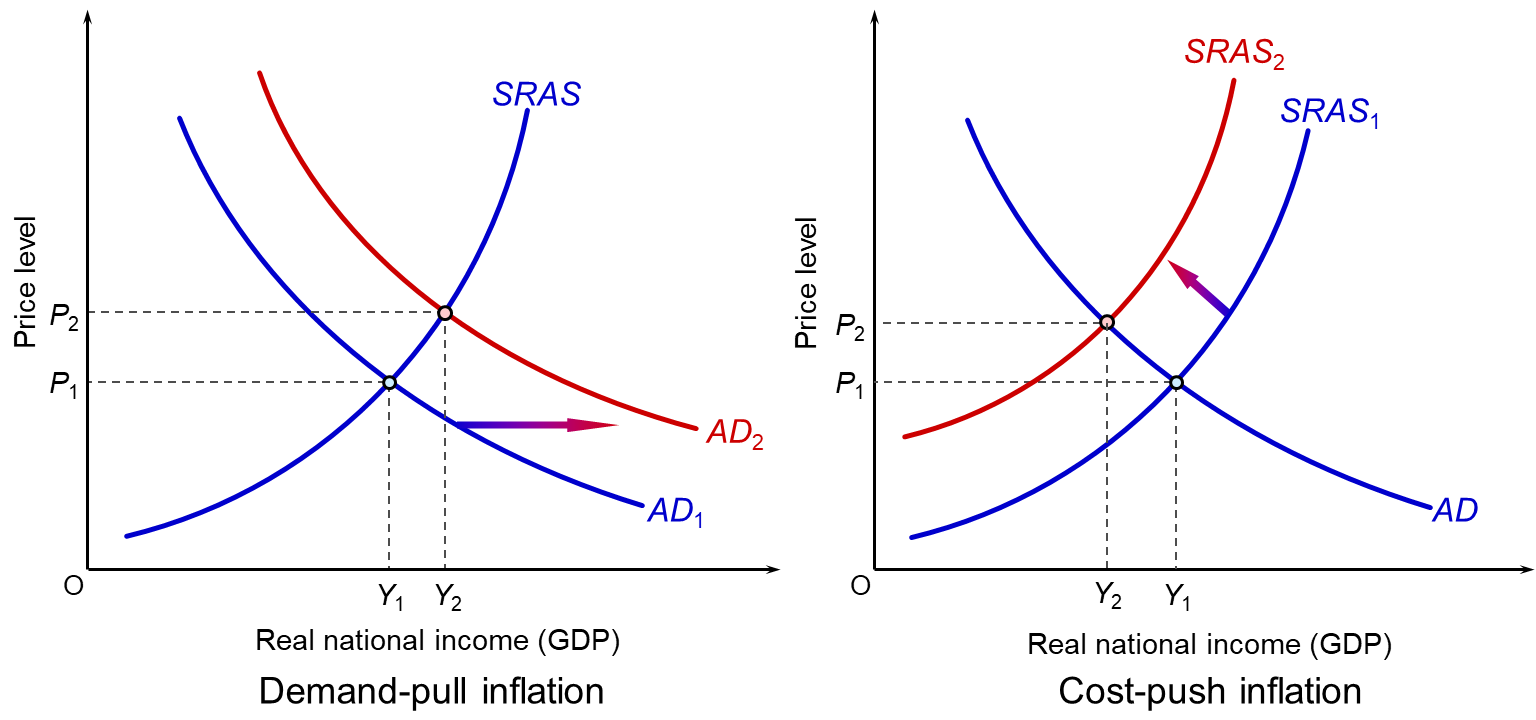
As you can see, the effects on real GDP (Y) are quite different. A rise in aggregate demand will tend to increase GDP (as long as capacity constraints allow). A rise in costs, and hence an upward shift in short-run aggregate supply, will lead to a fall in GDP as firms cut output in the face of rising costs and as consumers consume less as the cost of living rises.
The inflation experienced by the UK and other countries in recent months has been largely of the cost-push variety. Causes include: supply-chain bottlenecks as economies opened up after COVID-19; the war in Ukraine and its effects on oil and gas supplies and various grains; and avian flu and poor harvests from droughts and floods associated with global warming resulting in a fall in food supplies. These all led to a rise in prices. In the UK’s case, this was compounded by Brexit, which added to firms’ administrative costs and, according to the Bank of England, was estimated to cause a long-term fall in productivity of around 3 to 4 per cent.
The rise in costs had the effect of shifting short-run aggregate supply upwards to the left. As well as leading to a rise in prices and a cost-of-living squeeze, the rising costs dampened expenditure.
This was compounded by a tightening of fiscal policy as governments attempted to tackle public-sector deficits and debt, which had soared with the support measures during the pandemic. It was also compounded by rising interest rates as central banks attempted to bring inflation back to target.
Monetary policy response
 Central banks are generally charged with keeping inflation in the medium term at a target rate set by the government or the central bank itself. For most developed countries, this is 2% (see table in the blog, Should central bank targets be changed?). So is raising interest rates the correct policy response to cost-push inflation?
Central banks are generally charged with keeping inflation in the medium term at a target rate set by the government or the central bank itself. For most developed countries, this is 2% (see table in the blog, Should central bank targets be changed?). So is raising interest rates the correct policy response to cost-push inflation?
One argument is that monetary policy is inappropriate in the face of supply shocks. The supply shocks themselves have the effect of dampening demand. Raising interest rates will compound this effect, resulting in lower growth or even a recession. If the supply shocks are temporary, such as supply-chain disruptions caused by lockdowns during the pandemic, then it might be better to ride out the problem and not raise interest rates or raise them by only a small amount. Already cost pressures are easing in some areas as supplies have risen.
If, however, the fall in aggregate supply is more persistent, such as from climate-related declines in harvests or the Ukraine war dragging on, or new disruptions to supply associated with the Israel–Gaza war, or, in the UK’s case, with Brexit, then real aggregate demand may need to be reduced in order to match the lower aggregate supply. Or, at the very least, the growth in aggregate demand may need to be slowed to match the slower growth in aggregate supply.
Huw Pill, the Chief Economist at the Bank of England, in a podcast from the Columbia Law School (see links below), argued that people should recognise that the rise in costs has made them poorer. If they respond to the rising costs by seeking higher wages, or in the case of businesses, by putting up prices, this will simply stoke inflation. In these circumstances, raising interest rates to cool aggregate demand may reduce people’s ability to gain higher wages or put up prices.
 Another argument for raising interest rates in the face of cost-push inflation is when those cost increases are felt more than in other countries. The USA has suffered less from cost pressures than the UK. On the other hand, its growth rate is higher, suggesting that its inflation, albeit lower than in the UK, is more of the demand-pull variety. Despite its inflation rate being lower than in the UK, the problem of excess demand has led the Fed to adopt an aggressive interest rate policy. Its target rate is 5.25% to 5.50%, while the Bank of England’s is 5.25%. In order to prevent short-term capital outflows and a resulting depreciation in the pound, further stoking inflation, the Bank of England has been under pressure to mirror interest rate rises in the USA, the eurozone and elsewhere.
Another argument for raising interest rates in the face of cost-push inflation is when those cost increases are felt more than in other countries. The USA has suffered less from cost pressures than the UK. On the other hand, its growth rate is higher, suggesting that its inflation, albeit lower than in the UK, is more of the demand-pull variety. Despite its inflation rate being lower than in the UK, the problem of excess demand has led the Fed to adopt an aggressive interest rate policy. Its target rate is 5.25% to 5.50%, while the Bank of England’s is 5.25%. In order to prevent short-term capital outflows and a resulting depreciation in the pound, further stoking inflation, the Bank of England has been under pressure to mirror interest rate rises in the USA, the eurozone and elsewhere.
Articles
Blogs on this site
Information and data
Questions
- How may monetary policy affect inflationary expectations?
- If cost-push inflation makes people generally poorer, what role does the government have in making the distribution of a cut in real income a fair one?
- In the context of cost-push inflation, how might the authorities prevent a wage–price spiral?
- With reference to the second article above, explain the ‘monetary policy conundrum’ faced by the Bank of Japan.
- If central banks have a single policy instrument, namely changes in interest rates, how may conflicts arise when there is more than one macroeconomic objective?
- Is Russia’s rise in inflation the result of cost or demand pressures, or a mixture of the two (see articles above)?
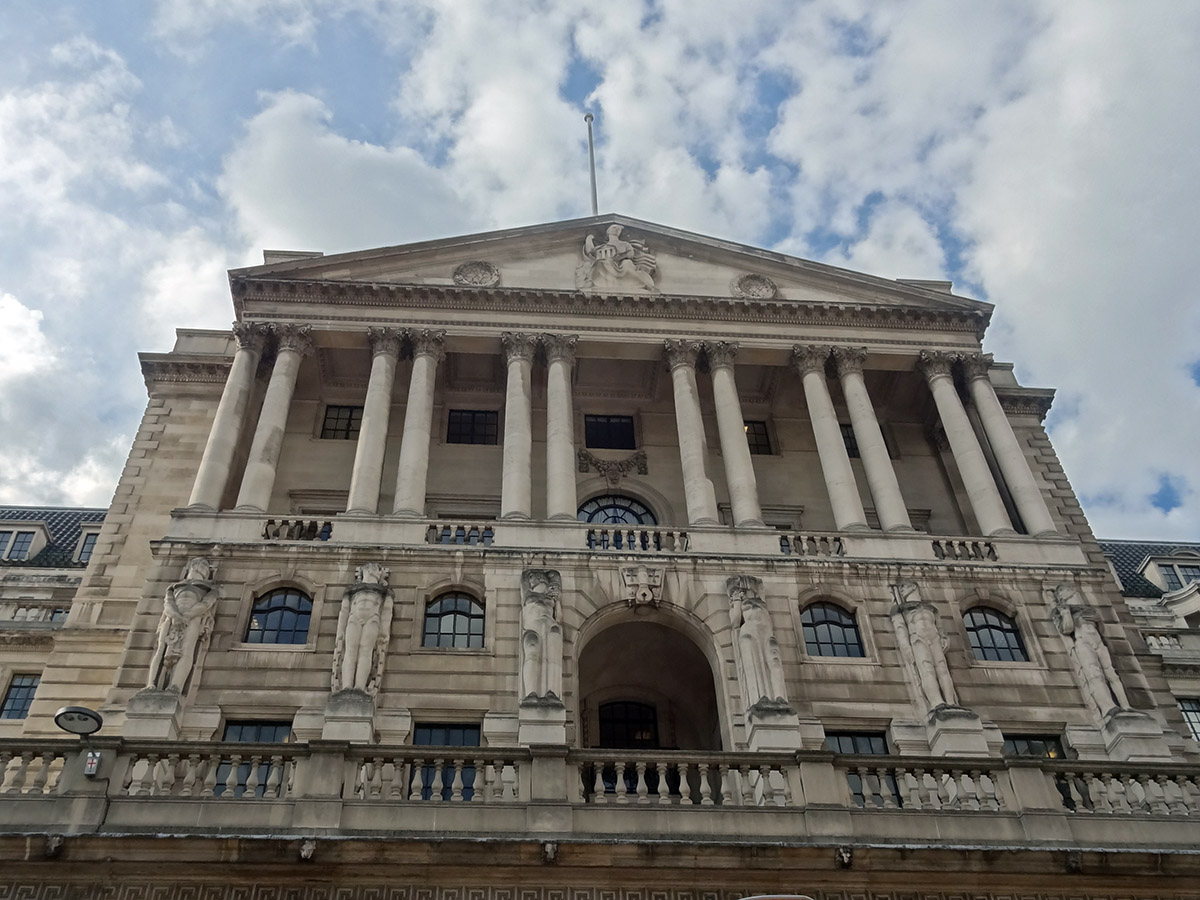 In this third blog about inflation, we focus on monetary policy to deal with the problem and bring inflation back to the target rate, which is typically 2 per cent around the world (including the eurozone, the USA and the UK). We ask the questions: was the response of central banks too timid initially, meaning that harsher measures had to be taken later; and will these harsher measures turn out to be excessive? In other words, has the eventual response been ‘too much, too late’, given that the initial measures were too little?
In this third blog about inflation, we focus on monetary policy to deal with the problem and bring inflation back to the target rate, which is typically 2 per cent around the world (including the eurozone, the USA and the UK). We ask the questions: was the response of central banks too timid initially, meaning that harsher measures had to be taken later; and will these harsher measures turn out to be excessive? In other words, has the eventual response been ‘too much, too late’, given that the initial measures were too little?
Inflation rates began rising in the second half of 2021 as economies began to open up as the pandemic subsided. Supply-chain problems drove the initial rise in prices. Then, following the Russian invasion of Ukraine in February 2022 and the adverse effects on oil, gas and grain prices, inflation rose further. In the UK, CPI inflation peaked at 11.1% in October 2022 (see chart 1 in the first of these three blogs). Across the whole EU-27, it peaked at 11.5% in October 2022; US inflation peaked at 9.1% in June 2022; Japanese inflation peaked at 4.3% in January 2023.
This raises the questions of why interest rates were not raised by a greater amount earlier (was it too little, too late?) and why they have continued to be raised once inflation rates have peaked (is it too much, too late?).
The problem of time lags
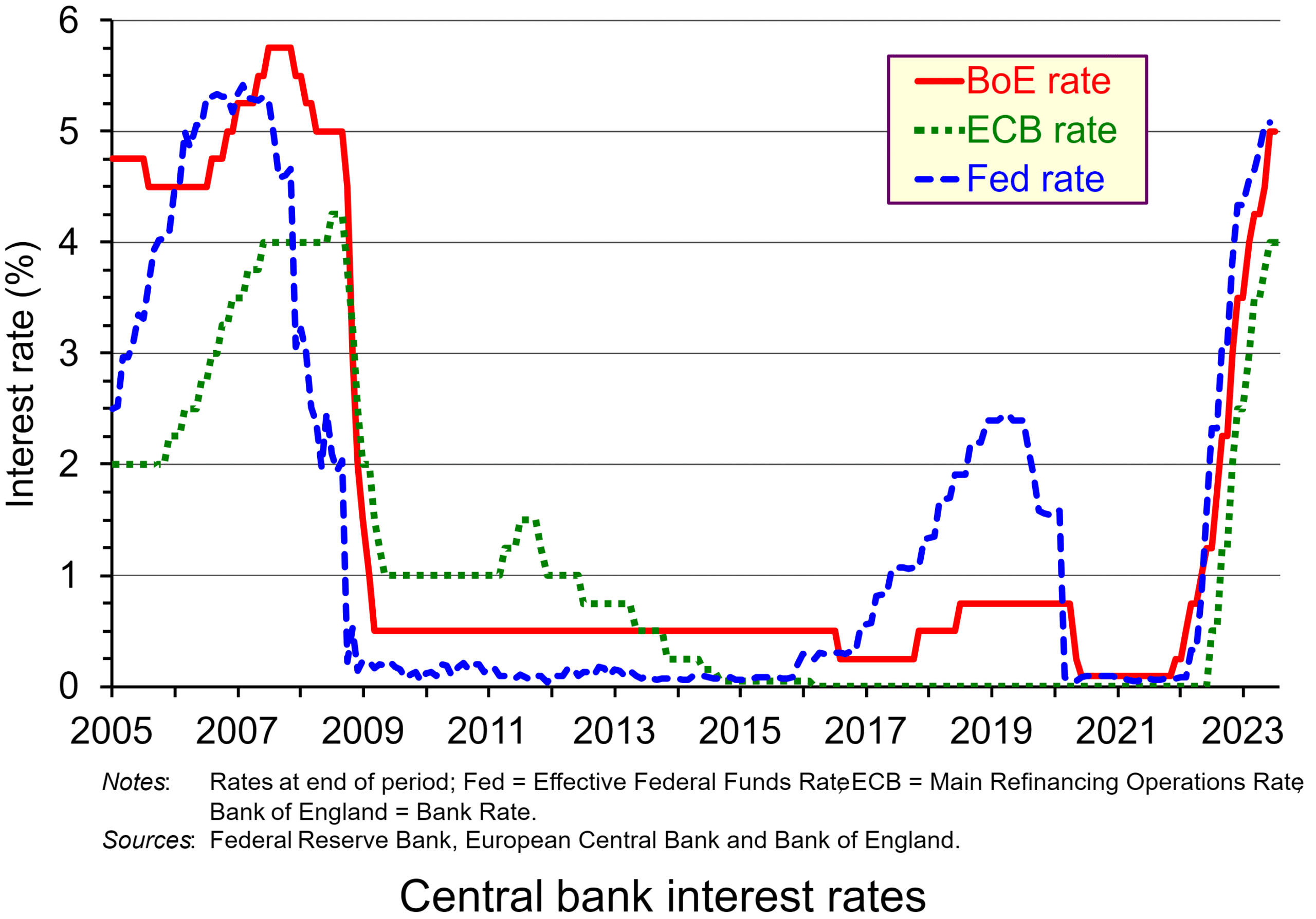 Both inflation and monetary policy involve time lags. Rising costs take a time to work their way through the supply chain. Firms may use old stocks for a time which are at the original price. If it is anticipated that costs will rise, central banks will need to take action early and not wait until all cost increases have worked their way through to retail prices.
Both inflation and monetary policy involve time lags. Rising costs take a time to work their way through the supply chain. Firms may use old stocks for a time which are at the original price. If it is anticipated that costs will rise, central banks will need to take action early and not wait until all cost increases have worked their way through to retail prices.
In terms of monetary policy, the lags tend to be long.
If central bank interest rates are raised, it may take some time for banks to raise savings rates – a common complaint by savers.
As far as borrowing rates are concerned, as we saw in the previous blog, loans secured on dwellings (mortgages) account for the majority of households’ financial liabilities (76.4% in 2021) and here the time lags between central bank interest rate changes and changes in people’s mortgage interest rates can be very long. Only around 14 of UK mortgages are at variable rates; the rest are fixed, typically for between 2 to 5 years. So, when Bank Rate changes, people on fixed rates will be unaffected until their mortgage comes up for renewal, when they can be faced with a huge increase in payments.
 Only around 21% of mortgages in England were/are due for renewal in 2023, and with 57% of these the old fixed rates were below 2%. Currently (July 2023), the average two-year fixed-rate mortgage rate in the UK is 6.81% (based on 75% loan to value (LTV)); the average five-year rate is 6.31% (based on 75% LTV). This represents a massive increase in interest rates, but for a relatively small proportion of homeowners and an even smaller proportion of total households.
Only around 21% of mortgages in England were/are due for renewal in 2023, and with 57% of these the old fixed rates were below 2%. Currently (July 2023), the average two-year fixed-rate mortgage rate in the UK is 6.81% (based on 75% loan to value (LTV)); the average five-year rate is 6.31% (based on 75% LTV). This represents a massive increase in interest rates, but for a relatively small proportion of homeowners and an even smaller proportion of total households.
But as more and more fixed-rate mortgages come up for renewal, so the number of people affected will grow, as will the dampening effect on aggregate demand as such people are forced to cut back on spending. This dampening effect will build up for many months.
And there is another time lag – that between prices and wages. Wages are negotiated periodically, normally annually or sometimes less frequently. Employees will typically seek a cost-of-living element in wage rises that covers price rises over the past 12 months, not inflation in the past month. If inflation is rising (or falling), such negotiations will not reflect the current situation. There is thus a time lag built in to such negotiations. Even if higher interest rates reduce inflation, the full effect can take some time because of this wages time lag.
 Other time lags include those involving ongoing capital projects. If construction is taking place, it will take some time to complete and in the meantime is unlikely to be stopped. Higher interest rates will affect capital investment decisions now, but existing projects are likely to continue to completion. As more projects are completed over time, so the effect of higher interest rates is likely to accumulate.
Other time lags include those involving ongoing capital projects. If construction is taking place, it will take some time to complete and in the meantime is unlikely to be stopped. Higher interest rates will affect capital investment decisions now, but existing projects are likely to continue to completion. As more projects are completed over time, so the effect of higher interest rates is likely to accumulate.
Then there is the question of savings. During the pandemic, many people increased their savings as their opportunities for spending were more limited. Since then, many people have drawn on these savings to fund holidays, eating out and other leisure activities. Such spending is likely to taper off as savings are reduced. Again, the interest rises may prove to have been excessive as a means of reducing aggregate demand.
These time lags suggest that after some months the economy will have been excessively dampened and that the policy will have ‘overshot’ the mark. Had interest rates been raised more rapidly earlier and by larger amounts, the peak level of rates may not have needed to be so high.
Perhaps one of the biggest worries about raising interest rates excessively because of time lags is the effect on corporate and government debt. Highly indebted companies and countries will find that a large increase in interest rates makes servicing their debt much harder. For example, Thames Water, the UK’s biggest water and sewerage company accumulated some £14 billion in debt during the era of low interest rates. It has now declared that it cannot service these debts and is on the brink of insolvency. In the case of governments, as increasing amounts have to be spent on servicing their debt, so they may be forced to cut expenditure elsewhere. This will have a dampening effect on the economy – but with a time lag.
The distribution of pain
 Those with large credit-card debt and large mortgages coming up for renewal or at variable rates will have borne the brunt of interest rate rises. These people, such as young people with families, are often those most affected by inflation, with a larger proportion of their expenditure on energy and food. Other people adversely affected are tenants where landlords raise rents to cover their higher mortgage payments.
Those with large credit-card debt and large mortgages coming up for renewal or at variable rates will have borne the brunt of interest rate rises. These people, such as young people with families, are often those most affected by inflation, with a larger proportion of their expenditure on energy and food. Other people adversely affected are tenants where landlords raise rents to cover their higher mortgage payments.
Those with no debts will have been little affected by the hike in interest rates, unless the curbing of aggregate demand affects their chances of overtime or reduces available shifts or, worse still, leads to redundancy.
Excessive rises in interest rates exacerbate these distributional effects.
Articles
- UK homeowners face huge rise in payments when fixed-rate mortgages expire
The Guardian, Richard Partington (17/6/23)
- Economic ‘Bazball’ will have replaced UK’s safety-first approach to inflation and growth by 2025
The Guardian, Larry Elliott (16/7/23)
- The Bank of Canada just hiked interest rates for the sixth time — is it too late?
The Conversation, Alexander David (27/10/22)
- Monetary Policy Report Press Conference Opening Statement
Bank of Canada, Tiff Macklem (12/7/23)
- Some reflections on Monetary Policy past, present and future
Bank of England, Speech, Michael Saunders (18/6/22)
- Expectations, lags, and the transmission of monetary policy
Bank of England, Speech, Catherine L. Mann (23/2/23)
- Europe’s monetary policy shift comes (too) late
DW, Henrik Böhme (6/9/22)
- Nobel Prize-winning economist says there’s no need for the Fed to keep hiking interest rates
CNBC, Sam Meredith (14/7/23)
- Three Uncomfortable Truths For Monetary Policy
IMF, Speech, Gita Gopinath (26/6/23)
- Inflation’s return changes the world
Financial Times, Martin Wolf (4/7/23)
- The next revolution in monetary policy is underway
Reuters, Felix Martin (30/6/23)
- Inflation may be coming down but its unequal effects can still have a big impact on wellbeing
The Conversation, Alberto Prati (19/7/23)
- Why central banks should stop raising interest rates
The Conversation, Muhammad Ali Nasir (27/9/23)
 Bank of England’s ‘regrettable’ mistakes fuelled inflation, its former top economist says
Bank of England’s ‘regrettable’ mistakes fuelled inflation, its former top economist saysSky News, Daniel Binns (5/9/23)
Questions
- For what reasons might a central bank be unwilling to raise interest rates by more than 0.25 or 0.5 percentage points per month?
- What instruments other than changing interest rates does a central bank have for influencing aggregate demand?
- Distinguish between demand-pull and cost-push inflation.
- Why might using interest rates to curb inflation be problematic when inflation is caused by adverse supply shocks?
- How are expectations of consumers and firms relevant in determining (a) the appropriate monetary policy measures and (b) their effectiveness?
- How could a careful use of a combination of monetary and fiscal policies reduce the redistributive effects of monetary policy?
- How might the use of ‘forward guidance’ by central banks reduce the need for such large rises in interest rates?
 Recently, a flurry of bankruptcies among non-bank financial intermediaries (NBFIs) in the USA has drawn attention to the risks associated with alternative credit channels in the shadow-banking sector – lending which is not financed with deposits. There is concern that this could be the start of a wave of bankruptcies among such NBFIs, especially given concerns about a potential downswing in the economic cycle – a time when defaults are more likely.
Recently, a flurry of bankruptcies among non-bank financial intermediaries (NBFIs) in the USA has drawn attention to the risks associated with alternative credit channels in the shadow-banking sector – lending which is not financed with deposits. There is concern that this could be the start of a wave of bankruptcies among such NBFIs, especially given concerns about a potential downswing in the economic cycle – a time when defaults are more likely.  In the 1980s, international regulations around traditional banking activities – taking deposits and making loans – were being formalised by the Bank for International Settlements (BIS) under what became known as the Basel framework (see, for example, Economics section 18.2 or Economics for Business section 28.2). For the first time, this stipulated liquidity and capital requirements for international banks relating to their traditional lending activities. However, at the same time the deregulation of financial markets and financial innovation provided banks with opportunities to derive revenues from a range of other financial services.
In the 1980s, international regulations around traditional banking activities – taking deposits and making loans – were being formalised by the Bank for International Settlements (BIS) under what became known as the Basel framework (see, for example, Economics section 18.2 or Economics for Business section 28.2). For the first time, this stipulated liquidity and capital requirements for international banks relating to their traditional lending activities. However, at the same time the deregulation of financial markets and financial innovation provided banks with opportunities to derive revenues from a range of other financial services.  These regulatory developments created an incentive to pursue activities which do not require as much capital, since their marginal cost is lower and potential return is higher. Consequently, banks have placed less emphasis on lending and more on purchasing short-term and long-term financial securities and generating non-interest income from off-balance sheet activities. For instance, research by the Bank of England found that during the 1980s, interest income accounted for more than two-thirds of total income for large international banks. In contemporary times, non-interest income tends to be greater than interest income. Figure 1 illustrates the declining proportion of total assets represented by commercial and consumer loans for all regulated US banks. (Click here for a PowerPoint.)
These regulatory developments created an incentive to pursue activities which do not require as much capital, since their marginal cost is lower and potential return is higher. Consequently, banks have placed less emphasis on lending and more on purchasing short-term and long-term financial securities and generating non-interest income from off-balance sheet activities. For instance, research by the Bank of England found that during the 1980s, interest income accounted for more than two-thirds of total income for large international banks. In contemporary times, non-interest income tends to be greater than interest income. Figure 1 illustrates the declining proportion of total assets represented by commercial and consumer loans for all regulated US banks. (Click here for a PowerPoint.) With banks originating less lending, activity has migrated to different avenues in the shadow-banking sector. This sector has always existed, but deregulation and financial innovation created opportunities for the growth of shadow banking – lending which is not financed with deposits. Traditionally, non-bank financial intermediaries (NBFIs), such as pension funds, hedge funds and insurance companies, use funds from investors to buy securities through financial markets. However, new types of NBFIs have emerged which originate loans themselves, notably private credit institutions. As Figure 2 illustrates, a lot of the expansion in the activities of NBFIs has been the due to increased lending by these institutions (defined as ‘other financial institutions (OFIs)). Note that the NBFI line includes OFIs. (Click here for a PowerPoint.)
With banks originating less lending, activity has migrated to different avenues in the shadow-banking sector. This sector has always existed, but deregulation and financial innovation created opportunities for the growth of shadow banking – lending which is not financed with deposits. Traditionally, non-bank financial intermediaries (NBFIs), such as pension funds, hedge funds and insurance companies, use funds from investors to buy securities through financial markets. However, new types of NBFIs have emerged which originate loans themselves, notably private credit institutions. As Figure 2 illustrates, a lot of the expansion in the activities of NBFIs has been the due to increased lending by these institutions (defined as ‘other financial institutions (OFIs)). Note that the NBFI line includes OFIs. (Click here for a PowerPoint.) Banking involves trade-offs and this is the case whether the activities happen in the regulated or shadow-banking sector. Increasing lending increases profitability. But as lending continues to increase, at some point the risk-return profile becomes less favourable since institutions are lending to increasingly higher-risk borrowers and for higher-risk projects.
Banking involves trade-offs and this is the case whether the activities happen in the regulated or shadow-banking sector. Increasing lending increases profitability. But as lending continues to increase, at some point the risk-return profile becomes less favourable since institutions are lending to increasingly higher-risk borrowers and for higher-risk projects. The financial system is highly interconnected, and each successive financial crisis has shown that systemic risks lurk in obscure places. On the face of it, NBFIs appear separate from regulated banks. But banks’ new business models have not removed them from the lending channel, merely changed their role. Short-term financing used to be conducted and funded by banks. Now, it is conducted by NBFIs, but still financed by banks. Long-term loan financing is no longer on banks’ balance sheets. However, while the lending is conducted by NBFIs, it is largely funded by banks.
The financial system is highly interconnected, and each successive financial crisis has shown that systemic risks lurk in obscure places. On the face of it, NBFIs appear separate from regulated banks. But banks’ new business models have not removed them from the lending channel, merely changed their role. Short-term financing used to be conducted and funded by banks. Now, it is conducted by NBFIs, but still financed by banks. Long-term loan financing is no longer on banks’ balance sheets. However, while the lending is conducted by NBFIs, it is largely funded by banks. Furthermore, banks have increasingly made loans to NBFIs. Data for US commercial banks lending to the shadow-banking sector are publicly available only since 2015. But, as Figure 3 illustrates, it has seen a steady upward trend with a surge in activity in 2025. (Click here for a PowerPoint.)
Furthermore, banks have increasingly made loans to NBFIs. Data for US commercial banks lending to the shadow-banking sector are publicly available only since 2015. But, as Figure 3 illustrates, it has seen a steady upward trend with a surge in activity in 2025. (Click here for a PowerPoint.) The level of debt in the global economy is at unprecedented levels. Data from the International Monetary Fund (IMF) show that it rose to $351 trillion dollars in 2024, approximately 235% of weighted global gross domestic product (GDP). It is in this environment that private credit channels through NBFIs have been expanding. With this, it is more likely that NBFIs’ trade-off between credit risk and return has tilted greatly in favour of the former. Some point to the recent collapse of Tricolor and First Brands – both intermediary financing companies funded by private credit – as evidence of elevated levels of risk.
The level of debt in the global economy is at unprecedented levels. Data from the International Monetary Fund (IMF) show that it rose to $351 trillion dollars in 2024, approximately 235% of weighted global gross domestic product (GDP). It is in this environment that private credit channels through NBFIs have been expanding. With this, it is more likely that NBFIs’ trade-off between credit risk and return has tilted greatly in favour of the former. Some point to the recent collapse of Tricolor and First Brands – both intermediary financing companies funded by private credit – as evidence of elevated levels of risk.  Gold has always held an allure and with the price of gold on international markets trending upwards since October 2022 (see Figure 1: click
Gold has always held an allure and with the price of gold on international markets trending upwards since October 2022 (see Figure 1: click  The relationship between real returns, proxied by the yield on US 10-year TIPS (Treasury inflation-protected securities), and gold prices can be used to examine this explanation. Real returns rose steadily in the aftermath of the COVID-19 pandemic. Yet the price of gold, which rose during the early stages of the pandemic in 2020, has not fallen. Instead, it has remained at elevated levels for much of that time (see Figure 2: click
The relationship between real returns, proxied by the yield on US 10-year TIPS (Treasury inflation-protected securities), and gold prices can be used to examine this explanation. Real returns rose steadily in the aftermath of the COVID-19 pandemic. Yet the price of gold, which rose during the early stages of the pandemic in 2020, has not fallen. Instead, it has remained at elevated levels for much of that time (see Figure 2: click  Since 2018, there have been bouts of gold purchasing by central banks around the world. In contrast to the 1990s and 2000s, central banks have been net purchasers since 2010. The purchasing fell back during the coronavirus pandemic but has surged again, with over 1000 metric tonnes purchased in both 2022 and 2023 (see Figure 3: click
Since 2018, there have been bouts of gold purchasing by central banks around the world. In contrast to the 1990s and 2000s, central banks have been net purchasers since 2010. The purchasing fell back during the coronavirus pandemic but has surged again, with over 1000 metric tonnes purchased in both 2022 and 2023 (see Figure 3: click  While the current period of central bank purchases does not appear to be related to expected inflation, some commentators suggest it could signal a regime change in the global financial system as significant as the collapse of Bretton Woods. The rise of Chinese political power and the resurgence of US isolationist tendencies portend an increasingly multipolar geopolitical scene. Such concerns may cause central bankers to diversify away from dollar denominated assets to avoid being caught out by geopolitical tensions. Gold may be perceived as an asset through which investors can hedge that risk better.
While the current period of central bank purchases does not appear to be related to expected inflation, some commentators suggest it could signal a regime change in the global financial system as significant as the collapse of Bretton Woods. The rise of Chinese political power and the resurgence of US isolationist tendencies portend an increasingly multipolar geopolitical scene. Such concerns may cause central bankers to diversify away from dollar denominated assets to avoid being caught out by geopolitical tensions. Gold may be perceived as an asset through which investors can hedge that risk better.  Finally, there are economists who argue that the increased demand for gold is caused by a different regime-change in the global economy. This is not one driven by geopolitics, but by changing inflationary expectations – from a low-inflation, low-interest-rate environment to a higher-inflation, higher-interest-rate environment.
Finally, there are economists who argue that the increased demand for gold is caused by a different regime-change in the global economy. This is not one driven by geopolitics, but by changing inflationary expectations – from a low-inflation, low-interest-rate environment to a higher-inflation, higher-interest-rate environment.
 To finance budget deficits, governments have to borrow. They can borrow short-term by
To finance budget deficits, governments have to borrow. They can borrow short-term by  Bonds can be sold on the secondary market (i.e. the stock market) before maturity. The market price, however, is unlikely to be the coupon price (i.e. the face value). The lower the coupon rate relative to current interest rates, the less valuable the bond will be. For example, if interest rates rise, and hence new bonds pay a higher coupon rate, the market price of existing bonds paying a lower coupon rate must fall. Thus bond prices vary inversely with interest rates.
Bonds can be sold on the secondary market (i.e. the stock market) before maturity. The market price, however, is unlikely to be the coupon price (i.e. the face value). The lower the coupon rate relative to current interest rates, the less valuable the bond will be. For example, if interest rates rise, and hence new bonds pay a higher coupon rate, the market price of existing bonds paying a lower coupon rate must fall. Thus bond prices vary inversely with interest rates.


 The chart shows the yield on 10-year government bonds. It is calculated using the ‘par value’ approach. This gives the coupon rate that would have to be paid for the market price of a bond to equal its face value. Clearly, as interest rates rise, a bond would have to pay a higher coupon rate for this to happen. (This, of course, is only hypothetical to give an estimate of market rates, as coupon rates are fixed at the time of a bond’s issue.)
The chart shows the yield on 10-year government bonds. It is calculated using the ‘par value’ approach. This gives the coupon rate that would have to be paid for the market price of a bond to equal its face value. Clearly, as interest rates rise, a bond would have to pay a higher coupon rate for this to happen. (This, of course, is only hypothetical to give an estimate of market rates, as coupon rates are fixed at the time of a bond’s issue.)  In the years following the financial crisis of 2007–8 and the subsequent recession, and again during the COVID pandemic, central banks cut interest rates and supported this by quantitative easing. This involved central banks buying existing bonds on the secondary market and paying for them with newly created (electronic) money. This drove up bond prices and drove down yields (as the chart shows). This helped support the policy of low interest rates. This was a boon to governments, which were able to borrow cheaply.
In the years following the financial crisis of 2007–8 and the subsequent recession, and again during the COVID pandemic, central banks cut interest rates and supported this by quantitative easing. This involved central banks buying existing bonds on the secondary market and paying for them with newly created (electronic) money. This drove up bond prices and drove down yields (as the chart shows). This helped support the policy of low interest rates. This was a boon to governments, which were able to borrow cheaply. In the USA, there have been similar increases in government debt and debt interest payments. Debt has increased from $9tn in 2007 to $33.6tn today. Again, with higher interest rates, debt interest as a percentage of GDP has risen: from 1.5% of GDP in 2021 to a forecast 2.5% in 2023 and 3% in 2024. What is more, 31 per cent of US government bonds will mature next year and will need refinancing – at higher coupon rates.
In the USA, there have been similar increases in government debt and debt interest payments. Debt has increased from $9tn in 2007 to $33.6tn today. Again, with higher interest rates, debt interest as a percentage of GDP has risen: from 1.5% of GDP in 2021 to a forecast 2.5% in 2023 and 3% in 2024. What is more, 31 per cent of US government bonds will mature next year and will need refinancing – at higher coupon rates. We have examined inflation in several blogs in recent months. With inflation at levels not seen for 40 years, this is hardly surprising. One question we’ve examined is whether the policy response has been correct. For example, in July, we asked whether the Bank of England had raised interest rates
We have examined inflation in several blogs in recent months. With inflation at levels not seen for 40 years, this is hardly surprising. One question we’ve examined is whether the policy response has been correct. For example, in July, we asked whether the Bank of England had raised interest rates 
 Central banks are generally charged with keeping inflation in the medium term at a target rate set by the government or the central bank itself. For most developed countries, this is 2% (see table in the blog,
Central banks are generally charged with keeping inflation in the medium term at a target rate set by the government or the central bank itself. For most developed countries, this is 2% (see table in the blog,  Another argument for raising interest rates in the face of cost-push inflation is when those cost increases are felt more than in other countries. The USA has suffered less from cost pressures than the UK. On the other hand, its growth rate is higher, suggesting that its inflation, albeit lower than in the UK, is more of the demand-pull variety. Despite its inflation rate being lower than in the UK, the problem of excess demand has led the Fed to adopt an aggressive interest rate policy. Its target rate is 5.25% to 5.50%, while the Bank of England’s is 5.25%. In order to prevent short-term capital outflows and a resulting depreciation in the pound, further stoking inflation, the Bank of England has been under pressure to mirror interest rate rises in the USA, the eurozone and elsewhere.
Another argument for raising interest rates in the face of cost-push inflation is when those cost increases are felt more than in other countries. The USA has suffered less from cost pressures than the UK. On the other hand, its growth rate is higher, suggesting that its inflation, albeit lower than in the UK, is more of the demand-pull variety. Despite its inflation rate being lower than in the UK, the problem of excess demand has led the Fed to adopt an aggressive interest rate policy. Its target rate is 5.25% to 5.50%, while the Bank of England’s is 5.25%. In order to prevent short-term capital outflows and a resulting depreciation in the pound, further stoking inflation, the Bank of England has been under pressure to mirror interest rate rises in the USA, the eurozone and elsewhere. In this third blog about inflation, we focus on monetary policy to deal with the problem and bring inflation back to the target rate, which is typically 2 per cent around the world (including the eurozone, the USA and the UK). We ask the questions: was the response of central banks too timid initially, meaning that harsher measures had to be taken later; and will these harsher measures turn out to be excessive? In other words, has the eventual response been ‘too much, too late’, given that the initial measures were too little?
In this third blog about inflation, we focus on monetary policy to deal with the problem and bring inflation back to the target rate, which is typically 2 per cent around the world (including the eurozone, the USA and the UK). We ask the questions: was the response of central banks too timid initially, meaning that harsher measures had to be taken later; and will these harsher measures turn out to be excessive? In other words, has the eventual response been ‘too much, too late’, given that the initial measures were too little?  Both inflation and monetary policy involve time lags. Rising costs take a time to work their way through the supply chain. Firms may use old stocks for a time which are at the original price. If it is anticipated that costs will rise, central banks will need to take action early and not wait until all cost increases have worked their way through to retail prices.
Both inflation and monetary policy involve time lags. Rising costs take a time to work their way through the supply chain. Firms may use old stocks for a time which are at the original price. If it is anticipated that costs will rise, central banks will need to take action early and not wait until all cost increases have worked their way through to retail prices. Only around 21% of mortgages in England were/are due for renewal in 2023, and with 57% of these the old fixed rates were below 2%. Currently (July 2023), the average two-year fixed-rate mortgage rate in the UK is 6.81% (based on 75% loan to value (LTV)); the average five-year rate is 6.31% (based on 75% LTV). This represents a massive increase in interest rates, but for a relatively small proportion of homeowners and an even smaller proportion of total households.
Only around 21% of mortgages in England were/are due for renewal in 2023, and with 57% of these the old fixed rates were below 2%. Currently (July 2023), the average two-year fixed-rate mortgage rate in the UK is 6.81% (based on 75% loan to value (LTV)); the average five-year rate is 6.31% (based on 75% LTV). This represents a massive increase in interest rates, but for a relatively small proportion of homeowners and an even smaller proportion of total households. Other time lags include those involving ongoing capital projects. If construction is taking place, it will take some time to complete and in the meantime is unlikely to be stopped. Higher interest rates will affect capital investment decisions now, but existing projects are likely to continue to completion. As more projects are completed over time, so the effect of higher interest rates is likely to accumulate.
Other time lags include those involving ongoing capital projects. If construction is taking place, it will take some time to complete and in the meantime is unlikely to be stopped. Higher interest rates will affect capital investment decisions now, but existing projects are likely to continue to completion. As more projects are completed over time, so the effect of higher interest rates is likely to accumulate. Those with large credit-card debt and large mortgages coming up for renewal or at variable rates will have borne the brunt of interest rate rises. These people, such as young people with families, are often those most affected by inflation, with a larger proportion of their expenditure on energy and food. Other people adversely affected are tenants where landlords raise rents to cover their higher mortgage payments.
Those with large credit-card debt and large mortgages coming up for renewal or at variable rates will have borne the brunt of interest rate rises. These people, such as young people with families, are often those most affected by inflation, with a larger proportion of their expenditure on energy and food. Other people adversely affected are tenants where landlords raise rents to cover their higher mortgage payments.